Szijjártó: Nuclear Power Could Mean More Energy Security for Hungary

The construction of additional nuclear power units at Paks is on schedule and on course to make Hungary more competitive while protecting the environment, Minister of Foreign Affairs Péter Szijjártó insists. 16
Is Cabinet Mulling Action on Fuel Costs to Boost Growth?
Could the government be mulling another intervention to limit fuel prices in a short-term bid to boost growth, consumption and the value added tax take? 17
‘Unity and Cooperation’
Smile, You’re in Hungary Now!
If you see rather more people on the streets of Budapest beaming from ear to ear today (Friday, Oct. 6) than usual, today is World Smile Day, dreamed up by the man who created the internationally recognized bright yellow smiley face, and Hungary is one of the countries grinning for good. 25
Retail Trade Likely to Drop Further
Businesses value stability, transparency, and a level playing field. German investments in Hungary have been a success story for decades, says Ambassador Julia Gross, one she wants to build on, despite some challenges. 10
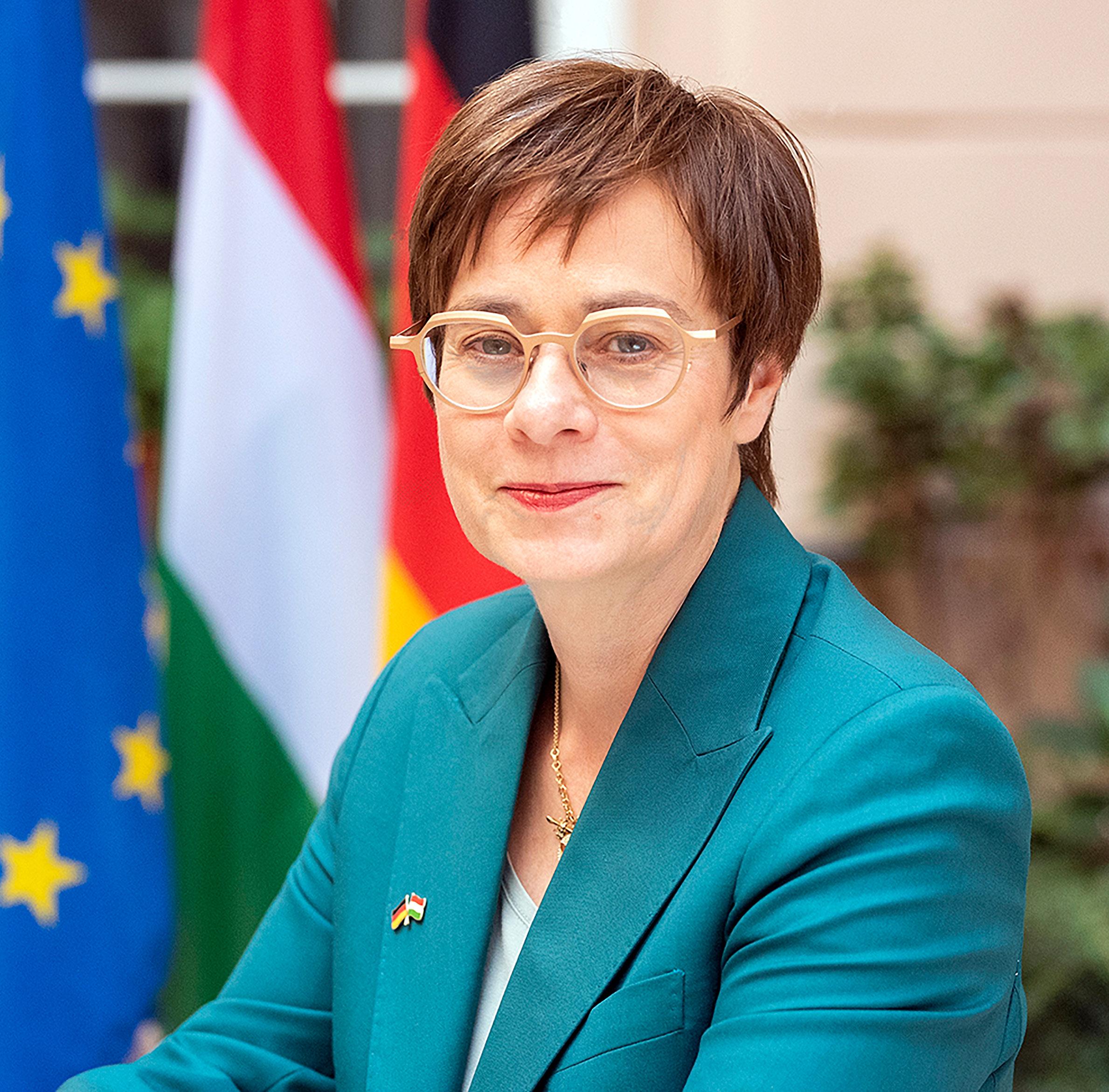
Hungary’s retail sector is still in decline, with the August data weaker than expected. Analysts thought domestic consumption would pick up from the previous month, but instead, it contracted further. This is not likely to change until real wages start to increase. 3
AutoWallis Balancing Growth and Chinese Competitors
Public investor day reveals that, despite “robust growth” for AutoWallis, the industry cannot ignore the advance of Chinese competitors on the Hungarian and regional automotive markets. 7
SOCIALITE
NEWS
HUNGARY’S PRACTICAL BUSINESS BI-WEEKLY SINCE 1992 | WWW.BUDAPESTBUSINESSJOURNAL.COM
Energy SPECIAL REPORT INSIDE THIS ISSUE
BUSINESS
VOL. 31. NUMBER 18 | OCTOBER 6 – OCTOBER 19, 2023 HUF 2,100 | EUR 5 | USD 6 | GBP 4 FOCUS
EDITOR-IN-CHIEF: Robin Marshall
EDITORIAL CONTRIBUTORS: Luca Albert, Balázs Barabás, Zsófia Czifra, Kester Eddy, Bence Gaál, Gergely Herpai, David Holzer, Gary J. Morrell, Nicholas Pongratz, Gergő Rácz.
LISTS: BBJ Research (research@bbj.hu)

NEWS AND PRESS RELEASES: Should be submitted in English to news@bbj.hu
LAYOUT: Zsolt Pataki

PUBLISHER: Business Publishing Services Kft.


CEO: Tamás Botka
ADVERTISING: AMS Services Kft.
CEO: Balázs Román
SALES: sales@bbj.hu
CIRCULATION AND SUBSCRIPTIONS: circulation@bbj.hu
Address: Madách Trade Center 1075 Budapest, Madách Imre út 13-14, Building B, 7th floor. Telephone +36 (1) 398-0344, Fax +36 (1) 398-0345, www.bbj.hu

The Budapest Business Journal, HU ISSN 1216-7304, is published bi-weekly on Friday, registration No. 0109069462. It is distributed by HungaroPress. Reproduction or use without permission of editorial or graphic content in
BREAKING THE HUNGARIAN NOBEL GLASS CEILING
VISIT US ONLINE: WWW.BBJ.HU

Why Support the BBJ?
• Independence. The BBJ’s journalism is dedicated to reporting fact, not politics, and isn’t reliant on advertising from the government of the day, whoever that might be.
• Community Building. Whether it is the Budapest Business Journal itself, the Expat CEO award, the Expat CEO gala, the Top Expat CEOs in Hungary publication, or the new Expat CEO Boardroom meeting, we are serious about doing our part to bind this community together.
• Value Creation. We have a nearly 30-year history of supporting the development of diversity and sustainability in Hungary’s economy. The fact that we have been a trusted business voice for so long, indeed we were the first English-language publication when we launched back on November 9, 1992, itself has value.
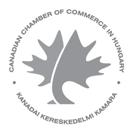

• Crisis Management. We have all lived through a once-in-a-century pandemic. But we also face an existential threat through climate change and operate in a period where disruptive technologies offer threats and opportunities. Now, more than ever, factual business reporting is vital to good decision-making.
For more information visit budapestbusinessjournal.com
The British have a saying: you wait around at a bus stop for hours, and then three buses turn up simultaneously. I have no empirical evidence for how reliable a measure this really is when it comes to omnibus transportation, but its use has been expanded to cover just about anything you find yourself waiting for. Like Nobel prizes. The official Hungarian tally for Nobel laureates, as recognized by the Hungarian Academy of Sciences, had stood at 13 since 2004, when Avram Hershko (born Ferenc Herskó in Karcag, 168 km east of Budapest by road, in 1937) won for chemistry. Just two years earlier, in 2002, another laureate of Jewish descent, Imre Kertész, the author of “Fateless,” had become the first Hungarian to win the literature prize. They were at the head of a remarkable lineage that goes back to the first Hungarian winner in 1905, Philipp Lenard (Philipp Eduard Anton von Lenard, to his friends), who won the physics prize for his work on cathode rays. Lenard is an interesting case study of how messy Hungarian history can be and also demonstrates how hard it can be to pinpoint which winners come from where. He is listed as a German physicist by britannica. com, for example, and was born in 1862 in what was then Pressburg (Pozsony to Hungarians), Hungary but is today Bratislava, Slovakia. I have no idea if the Czechoslovaks claimed him as one of their own back in the day, or if the Slovaks do today. You could imagine that they might, but no winners are listed on the Wikipedia national breakdown. Lenard is also a case study of how what is viewed as acceptable changes with time. His was clearly a brilliant mind, but he was not a brilliant human. Britannica says of him: “An ardent
supporter of Nazism, Lenard publicly denounced ‘Jewish’ science, including Albert Einstein’s theory of relativity.” Anyway, back to those buses. After a wait of 19 years without a Hungarian Nobel laureate, this week we got two: Katalin Karikó (a graduate of Szeged University) for medicine and Ferenc Krausz (whose alma mater is the Budapest University of Technology and Economics) for physics. Meaning no disrespect to Krausz (and glossing over the fact that I have absolutely no idea what his work on attosecond pulses of light for the study of electron dynamics in matter means in the grand scheme of things), let us take a moment to celebrate Karikó. The work she and co-winner Drew Weissman, an American immunologist, did on mRNA led directly to the BioNTech/ Pfizer and Moderna vaccines against COVID-19. That will instantly make her a hero to countless millions worldwide and a villain to a tiny number of conspiracy theorists and anti-vaxxers. Never mind that, or that she apparently felt stifled in pursuing research in Hungary and moved to America to stretch her ambitions and brain. Let us just glory in the fact that she has shattered the glass ceiling for female Hungarian Nobel prize winners. She is also the latest in a list of 62 women to have won 63 prizes, stretching back to Marie Curie, who won in 1903 (physics), and then again in 1911 (chemistry). Here’s to many more female laureates, globally, of course, but also specifically in Hungary. It would be nice if a few of them felt encouraged and able to do their work here, to boot.
Robin Marshall Editor-in-chief
NOW
In the color photo from state news agency MTI, Captain Bence Gieszer (second from left, wearing the beret), of the Ludovika University of Public Service (NKE) Faculty of Military Science and Military Officer Training, talks with third-year military officer candidates on a Leopard 2A4HU tank, which was presented to NKE for educational purposes on Oct. 3.

In the black and white picture from the Fortepan public archive, dating from 1944, a Panzerkampfwagen VI B, also known as the “King Tiger” tank, stands guard in front of the Fisherman’s Bastion in Budapest.

2 | 1 News www.bbj.hu Budapest Business Journal | October 6 – October 19, 2023
any manner is prohibited. ©2017 BUSINESS MEDIA SERVICES LLC with all rights reserved.
What We Stand For: The Budapest Business Journal aspires to be the most trusted newspaper in Hungary. We believe that managers should work on behalf of their shareholders. We believe that among the most important contributions a government can make to society is improving the business and investment climate so that its citizens may realize their full potential.
IMPRESSUM BBJ-PARTNERS
THEN &
THE EDITOR SAYS
Photo by Máthé Zoltán MTI
Photo by Album076 / Fortepan
1News
Retail Trade Seems Likely to Drop Further
Hungary’s retail sector is still in decline, with the August data proving to be even weaker than expected. With the gradual slowdown of the inflation rate, analysts thought domestic consumption would pick up from the previous month, but instead, it contracted further. This is not likely to change until real wages start to increase.
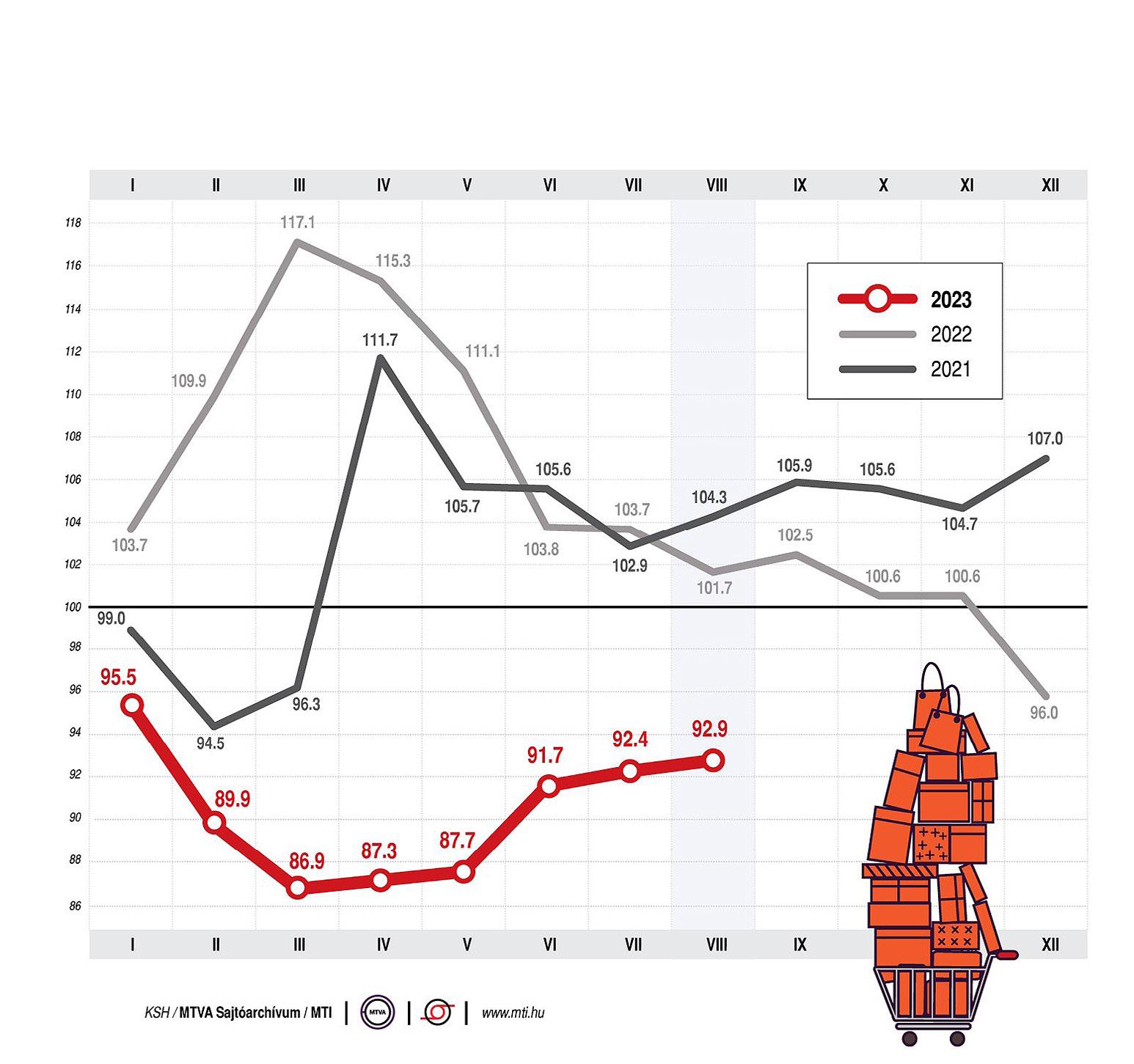
ZSÓFIA CZIFRA
The volume of retail trade declined by 7%, according to raw data, and by 7.1% when adjusted for calendar effects in August.
Sales revenue rose by 7.8% to HUF 1,594 trillion due to high inflation. Compared to the previous month, retail turnover decreased by 0.5%. In the first eight months, the volume of retail trade decreased by 9.6%, according to the fresh data released by the Central Statistical Office (KSH) on Oct. 4.
The volume of sales decreased by 4% in specialized and non-specialized food retailing year-on-year in August.
The volume decreased by 4.2% in non-specialized food and beverages stores (accounting for 75% of food retailing) and 3.4% in specialized food, beverage and tobacco stores.
The turnover of non-food retailing decreased by a total of 5.2% in volume in August compared to the same period of last year. Sales volumes rose by 4.8% in pharmaceutical, medical goods and cosmetics shops. In comparison, sales volumes decreased by 1% in second-hand goods shops, by 6% in books, computer
Volume of Retail Trade in Hungary
(August 2021-2023)
Calendar-adjusted volume index of retail trade (same period of previous year = 100)
High Base
The high base was mainly due to the fuel price cap, which significantly increased demand: while the KSH measured a 17.9% increase in the base period, this August, it fell by 18.1%. Due to the incorporation of high prices into the base and the reduction in prices of some products, the decline in the volume of food was smaller than before but still significant at 4%, Regős points out.
In the case of retail sales, on an annual basis, there will definitely be a decline in the coming months: real earnings will only start to increase from September, which will be visible for the first time in the October retail sales data.
Source:
equipment and other specialized stores, by 7.8% in textiles, clothing and footwear shops, by 11% in non-specialized shops dealing in manufactured goods and by
15%
in furniture and electrical goods stores.
The volume of mail order and internet retailing, accounting for 7.3% of all retail sales and involving a wide range of goods, was essentially unchanged. The sales volume in automotive fuel stations was 18.1% down compared to the same month last year. Sales in motor vehicles and motor vehicle parts and accessories stores not belonging to retail data were essentially unchanged.
According to Gergely Suppan, head analyst at MBH Bank Nyrt., the significant drop in retail sales in the spring months, in addition to the high base caused by the personal income tax refund and last year’s six-month gun money payments, is caused by the exceptionally high (albeit decreasing) inflation and the significant increase in household energy prices for households with higher than average consumption.
Lagging Effects
The decline in the turnover of food stores is still substantial but is getting milder. More conscious
and cautious purchases are reflected by the fact that sales growth in retail stores lags behind wage dynamics and that volume declines lag behind the decline in real wages.
That suggests that households are increasing their savings, as evidenced by household financial accounts or spending on other services, says Suppan. He believes one-off base effects also helped cause the notable drop in retail sales.
As for the near future, he notes that, for the rest of the year, due to the everlower base, the rate of decline in the retail sector may gradually ease and that it has already passed the low point.
“Due to easing inflation and the expected turnaround in real wages in September, we can already expect a pick-up in the coming months,” he says. “The decrease on a monthly basis is what caused the negative surprise since we could have expected an increase here with the gradual slowdown of inflation,” Makronóm Institute’s head economist Gábor Regős argues.
“The year-on-year decline is not a surprise, as it resulted from the high base and the 2% drop in real earnings in July, as households spend their July wages in August.”
The turnover of non-food stores fell by 5.2%. At the same time, the postponement of non-essential, higher-value purchases is still typical: a double-digit volume decrease was measured in the case of industrial goods and furniture and technical goods. Growth was achieved only in the case of pharmacies, where the increase in volume amounted to
4.8%,
meaning that Hungarian households have money for the most necessary things. The decrease in the volume of retail trade significantly exceeds the EU average, where the rate of decline was 1.2% in July.
In the case of retail sales, on an annual basis, there will definitely be a decline in the coming months: real earnings will only start to increase from September, which will be visible for the first time in the October retail sales data.
At the same time, due to the high base caused by the fuel price cap, the volume of retail trade can only show annual growth at the end of the year or at the beginning of next year, according to Regős.
“On the other hand, on a monthly basis, we can hope for the livening of consumption since this is also a condition for a recession of only a few tenths of a percentage point to occur in the Hungarian economy this year. This now has perhaps much less of an income-related barrier than of consumer sentiment,” he adds.
www.bbj.hu Budapest Business Journal | October 6 – October 19, 2023
• macroscope
ConvergenCE Officially Opens the Academia Office Center
The 12,500 sqm Academia office center redevelopment on the Pest embankment of the Danube in central District V has officially opened. Europa
Capital purchased the 12,500 sqm building, then called Akadémia, in partnership with ConvergenCE as asset manager, inJanuary 2022.
The partnership has since undertaken an extensive renovation of the historic building, bringing the complex to the standard required for Breeam, Well, Acccess4You and WiredScore accreditation (the latter being a first for the technology certificate in Hungary). Certification is ongoing.
The office interiors and common areas have been redeveloped to meet current tenant demands. ConvergenCE has emphasized the novelty value of the project’s sustainable and ESG-compliant space in a central business district location.
A notable development option in the Budapest office market is for the redevelopment and renovation of existing quality buildings, particularly in the CBD, where there is a scarcity of building plots, but there are listed buildings needing renovation. Despite this, the CBD sub-market has the lowest amount of office space under construction in Greater Budapest due to the difficulties of developing office projects.
Convergence and Europe Capital have been working together since
2005
with notable office developments such as the Eiffel Square, Kálvin Square, and B52 redevelopments. All these projects have successfully attracted buyers.

Real Estate Matters
A biweekly look at real estate issues in Hungary and the region
“ESG requirements are mainly tenant-lead; therefore, we designed our Academia project based on those principles in collaboration with BuildExt, an innovative Hungarian architectural company,” Zeley explains.
“In the CBD, there are very few developments and no newly built projects at all. To comply with sustainability initiatives, we do not build new buildings from the ground but focus on valueadded developments of existing buildings that require refurbishment,” he says.
Zeley said although the building is now complete, a few operations are still ongoing, and certifications are in progress.
The Akadémia building was bought for the Europa Capital value-add Europa Fund V1, with project financing provided by Erste Bank. The building was originally constructed between 1861-63.
“With our investor partners, we buy under-positioned buildings in great locations, which we renovate and refurbish with state-of-theart technology and services, then reposition and re-let,” says Csaba Zeley, managing director of ConvergenCE.
Highest Ratings
“We pay great attention to ensuring that all our properties have the highest environmental ratings. Obtaining certification is not just regulatory compliance, but also a cost-saving, value-added aspect, a crucial factor in sales and leasing,” he insists.
EC, Hungary and Ukraine all Maneuver on Funding, Accession
The European Commission is reportedly preparing to release EUR 13 billion in frozen funds to Hungary to solicit further support for Ukraine, both in securing continued funding during the war and in launching talks for the country’s accession to the EU.
In December, EU member states are scheduled to decide whether to allow Ukraine to begin accession negotiations, which would require unanimous agreement from all 27 countries. Prime Minister Viktor Orbán told Kossuth Rádió as recently as Sep. 29 that “very
difficult questions” still needed to be answered before the EU could even start membership talks, such as the issue of Ukraine’s treatment of its ethnic Hungarian minority population.
The bloc also hopes to bolster its financial support for Ukraine, which is expected to run out by December, with an additional EUR 50 bln. Hungary has suggested that halving that amount to EUR 25 bln would be sufficient for Ukraine at this stage, with an additional EUR 25 bln coming after an evaluation halfway through the 2024-2027 disbursement period.
To facilitate Hungary’s cooperation in both these endeavors, senior EU officials told the Financial Times that it was preparing to unlock EUR 13 bln of funding that has been withheld over rule-of-law and corruption concerns. “
“I can’t imagine Hungary agreeing without there first being a solution to the blocked funds,” said one EU official. A second confirmed a connection between
“I am proud to announce that Academia will soon become the first non-new construction Well ‘Platinum’ building in Hungary. Breeam certification is underway, and we are on the verge of obtaining the ‘BB’ energy certificate, a level even new office buildings in Budapest rarely achieve,” Zeley says. Academia is a rare completion in a market with a low pipeline currently. CBRE estimates the total office completions in the Budapest office market to be
180,000 sqm by year-end. For 2024, it estimates 114,000 sqm of delivery, two-thirds already preleased. In the following year, 2025, just 67,000 sqm of space is expected to be delivered.
CBRE has also identified 15 projects where construction has not started, but planning is at an advanced stage. These have a combined volume of 311,000 sqm and could be completed by 2027.
Roundup Crisis
releasing funds to Hungary and EU plans requiring unanimity, namely in the enlargement and budget talks, while a third confirmed the EUR 13 bln figure.
December Freeze
In December last year, the EU froze EUR 22 bln in cohesion funds, intended to narrow the investment gap and improve the infrastructure of less developed member states, allotted to Hungary, having determined that the Orbán’s government was failing to comply with regulations protecting human rights and the rule of law.
Following the report from the Financial Times, Minister of Regional Development Tibor Navracsics told journalists that he believed Hungary would reach an agreement with the EC to access the country’s EU funding by the end of the year. He said the latest press report “underpinned an optimism” he had held during the negotiations for the financing
over the past year and a half. According to Navracsics, the government had not received official communication about the situation. He added that it had become a “tradition” to learn of the EC’s position from the press.
However, in yet another twist, European Commission VP Vera Jourova categorically rejected the press reports an agreement was in the pipeline. At a press conference in Strasbourg on Oct. 3, she said the suggestion was “baseless speculation.”
Meanwhile, Ukraine’s National Agency on Corruption Prevention (NACP) removed OTP Bank from its list of “war sponsors,” according to the agency’s press service.
“During the discussions that lasted for the last few days 24/7 with the participation of the EU External Action Service, OTP Bank made a number of commitments regarding its future plans for the Russian market,” the press release stated.
4 | 1 News www.bbj.hu Budapest Business Journal | October 6 – October 19, 2023
GARY J. MORRELL
Ukraine
NICHOLS PONGRATZ
The official opening of the Academia office. This space was previously part of the Raiffeisen Bank HQ and branch.
Workers Look to Keep Existing Jobs Amid Gloomy Fall News HR Matters
A monthly look at human resource issues in Hungary and the region
GKI Economic Sentiment Index and its Elements, 2019-2023
Moody’s praised “the availability of skilled workers, one of the highest wage-adjusted labor productivities among EU countries, a solid infrastructure, one of the lowest corporate income tax rates among EU countries and its integration into European manufacturing production networks.”
Among other positive factors, Hungary is coping with a “moderately high” debt burden, while the “economic strength is expected to remain robust in light of significant investments.” Moody’s expected Hungary to “ultimately receive most EU funds in a noisy, step-by-step process so that the impact from a delayed flow of EU funds on economic growth and public finances will be limited.”
The big question is how GDP growth will develop, and here, Moody’s expects stagnation this year, with expansion to resume next year at 3%,
driven by a recovery of the domestic economy and exports. Private consumption will benefit from real wage growth turning positive as consumer price inflation decelerates. So, there is much good news in Moody’s rationale and, more importantly, positive outlooks for the future. The present, however, remains grim.
On the same day Moody’s rating news was released, Hungary’s Central Statistical Office (KSH) published the Q2 figures, reaffirming the preliminary data of a decrease in GDP growth of 2.3%, the worst since 2020.
Industrial output fell by 5.7%, construction output by 6%. Farm output saved the figures from an even worse performance, as agriculture grew by 67.9% in annual terms due to favorable weather conditions this spring. Commerce registered a 12.6% shrinkage, tourism and hospitality were down 2.9%, and logistics by 6.2%.
10-month Cycle
Household consumption decreased by 1.6%. According to other KSH statistics, the real wage decrease has been continuous for 10 months in Hungary. Analysts estimate that internal consumption will not start growing in the next two quarters.
This is sustained by the solvency index (IFI) report released in early August by Intrum and GKI. The index summarizes the financial security of households in a single figure, factoring in income, the volume of loan debt, the value of savings, as well as the cost of living.
Compared to the first quarter, the IFI slightly improved in Q2, to 11.06 points from 6.51. However, it is still well behind compared to Q2 2022, when it stood at 35.33 points. Growth is hindered by inflation and stagnating wages, the report says.
If so, what caused the IFI growth from Q1 to Q2 this year? Judit Üveges, sales director at Intrum, says that the load debt component of IFI is the explanation. Households stopped taking out loans and concentrated
instead on repaying existing ones. So, they are not spending more; on the contrary, consumption fell by 2.5% in
Q1,
and more is expected this year as families dip into their savings. Moreover, it seems that some have already depleted these, given that new loans are mainly directed to finance daily expenses, Üveges explains.
Other data confirms these findings. A survey conducted by workforce placement firm Trenkwalder indicates that among employees working at private companies, almost half (48%) are unsatisfied with their salaries and two-thirds (62%) feel their financial situation is worsening. Meanwhile, employers seem unable to address the dissatisfaction: only 28% of respondents said their company had raised their salary during the current year to compensate for inflation.
Trendkwalder also inquired how much higher salary would be required for employees to leave their current jobs. Two-thirds would do so for 30% more. But this is an unlikely situation, as demand for workers dropped this year, significantly limiting employee bargaining opportunities. Hence, the high rate (73%) of those who prioritize keeping their job rather than focusing on a salary raise.
Rollercoaster Confidence
A growing number of employees (53%) also feel that this year it is harder to find a job matching their profession, up from 45% last year. Other outlooks are not better, either.
In August, the GKI consumer confidence index reached a 16-month peak. “Both the assessment of own
financial position over the past 12 months and expectations for the next 12 months improved substantially. The perception of money that can be spent on high-value consumer goods also became more favorable,” GKI said at the time.
One month later, the party was over. In September, the index fell by three points. “Households assessed their own financial situation in the past 12 months as worsening compared to the previous month and had a similar view for the next 12 months. Households’ perception of their ability to spend money on high-value consumer goods over the next 12 months also deteriorated slightly,” GKI wrote.
In a separate analysis released on Sep. 21, GKI made forecasts for the economic environment this year and next. For 2023, GKI expects real earnings to fall by
1.5-2%,
but by the end of this year, they could grow substantially in the private sector.
Next year, however, three “major dilemmas” will shape the labor market: the treatment of the 2023 real earnings decline, the credibility of the government’s 2024 inflation forecast, and the acceptability to workers of a modest real earnings increase on average across the economy that does not threaten to restart the wage-price spiral.
“If the government were to advocate 6% in wage negotiations, it is possible that the minimum wage increase would be close to 10%, even in the face of employer opposition,” GKI estimates. If everything goes well, including economic productivity, real income and consumption could grow by around 2%, according to the GKI forecast.

1 News | 5 www.bbj.hu Budapest Business Journal | October 6 – October 19, 2023
BALÁZS BARABÁS
At the start of last month, the Hungarian government received some news that was probably accompanied by a great sigh of relief: Moody’s Investors Service affirmed the “Baa2” rating for Hungary, maintaining a “stable” outlook on Sep. 1.
Business confidence index
Consumer confidence index GKI economic sentiment index
The goal of the transformation is to include a representative of the next generation of lawyers in the management of the office, while Szabó wished to focus on professional work and client service and step back from management duties. Accordingly, as a member whose name is in the company’s name, he will continue representing clients as an active lawyer.
Szabó has almost 40 years’ experience in corporate and commercial law in Hungary and internationally. He specializes in commercial contracts, property purchases and developments, corporate restructuring, and the acquisition of company shares. He co-founded SZKT Andersen, which has been operating since 1996.


Dominek joined the law firm in September 2010 and has been a partner since December 2015. His main areas of expertise include competition law, consumer law, and M&A advisory. Several professional awards have acknowledged his work.
Managing Partner Appointed at Andersen Legal
Balázs Dominek joined Szabó, Kelemen & Partners Andersen Attorneys’ (SZKT Andersen) fourmember management team as managing partner at the beginning of June. Tamás Szabó, former managing partner of SZKT Andersen, will continue his work as senior partner.
SZKT Andersen has four managing partners: László András Kelemen, Domonkos Kiss, Péter Vincze, and Dominek.
Andor Nagy Joins Dentons Budapest

Dentons has announced the addition of Andor Nagy to its public law and regulatory practice in Budapest.
“We are thrilled to welcome Andor Nagy to the Dentons family,” shares Gábor Király, managing partner at Dentons Budapest.
“Andor’s strong legal background and unwavering dedication to public service and diplomacy will not only strengthen our team but also elevate our capabilities in meeting our clients’ diverse needs,” he adds.
According to Dentons, Nagy “brings a wealth of experience in public administration and diplomacy and, in his new role, will advise clients on projects related to public law and government relations.”
Before joining Dentons, Nagy served ambassador postings for Hungary in Vienna and Tel Aviv. His past service also includes stints as head of staff of the Prime Minister and later as a Member of Parliament.
Nagy has received the Staufer Medaille from the Prime Minister of Baden-Württemberg, amongst other prestigious accolades.
His long-standing association with the István Bibó College, dating back to 1983, reflects his commitment to the education and development of future leaders, Dentons notes.
Nagy is chairman of the MBH Bank supervisory board and holds leadership roles in the National Council for Sustainable Development and the Environmental Protection Committee.
Procter & Gamble Appoints Senior VP for Central Europe
Uluc Ayik took up on Sep. 1 the position of senior vice president for Procter & Gamble’s Central European Region, responsible for business operations in 10 countries, including Hungary, as well as the Baltic States, Croatia, the Czech Republic, Poland, Slovakia, Slovenia, and Ukraine.
“I am honored to take over the leadership of P&G’s Central Europe organization. I look forward to working with P&G’s talented and dedicated people, innovating to deliver the best possible service to the region’s 120 million consumers, and creating value with our partners. Central Europe, with its size and huge growth potential, plays a key role in P&G’s European and global business, and I see it as an important goal to continue to serve our communities and act as a driver of economic growth,” Ayik said.
marketing, sales, and general management positions, including local and regional management.
Earlier, he was responsible for the business operations of several of P&G’s core categories in Turkey and beyond. Before assuming responsibility for Central Europe, he served as senior VP of textile care in India, the Middle East, and Africa, serving consumers in more than 70 countries. Ayik is married and has two sons.
Energy Lawyer Joins RVD Partners
Márk Köles, an expert with 12 years of experience in energy law, has joined RVD Partners, the law firm.
A graduate of the University of Debrecen, Köles later obtained a postgraduate degree in energy law at the University of Pécs. He is an expert in the district heating sector. Throughout his career, he has been involved in price regulation and licensing, including preparing legislation, managing administrative procedures, and in respective litigations.
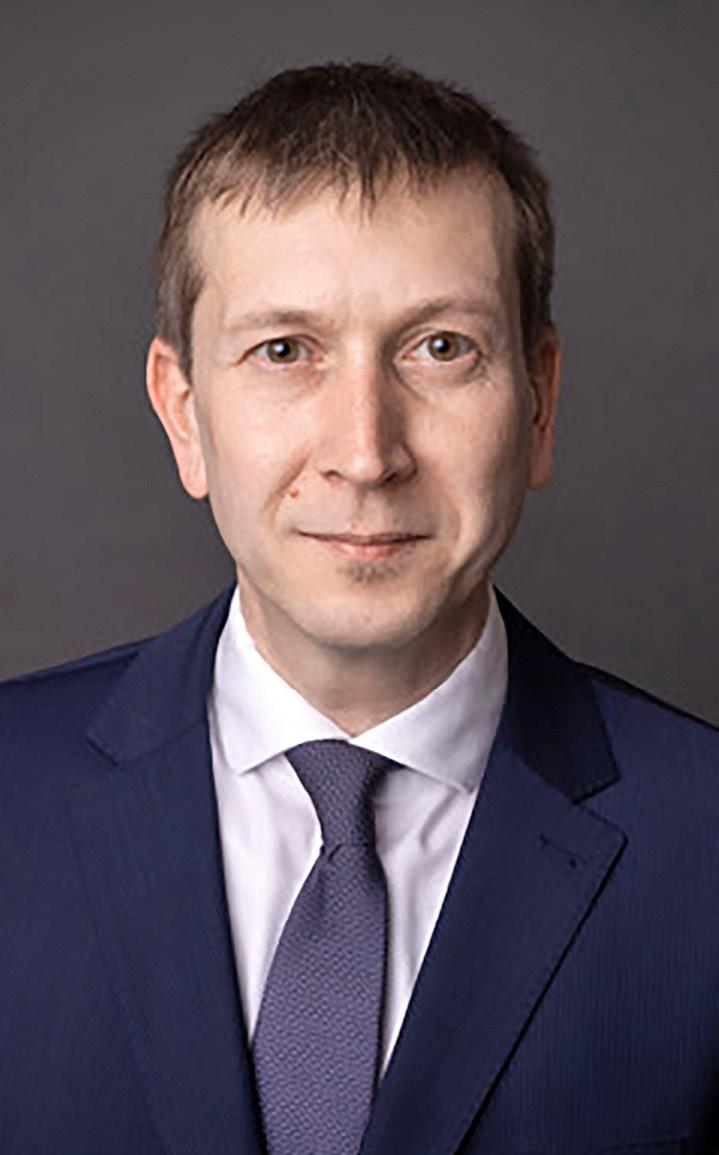
In 2011, he joined the predecessor of the Hungarian Energy and Public Utility Regulatory Authority (Mekh), becoming a unit head and then deputy head of department.
Szabó will support the managing partners in his new role as senior partner, and they will continue to rely on his expertise and decades of experience in this new role, the law firm tells the Budapest Business Journal

He also acted as chief of staff for the Fidesz-Hungarian Civic Party and was a Political State Secretary of the Prime Minister’s Office during the government’s formation in 1998. In recognition of his contributions to various civic and political roles,
The senior VP graduated in business management and administration from Bosphorus University in Istanbul and joined P&G Turkey in 1996. He worked in various
RVD Partners, a Budapestbased boutique law firm, was founded in 2021 by senior lawyers Levente Rövid, Zoltán Gyönyörű, and Gábor Rozsnyai, who have decades of combined experience gained at international and domestic law firms.
The firm is focused on business law, although it can provide legal assistance in the jurisdictions of almost 20 European countries through its membership in the Cyrus Ross European Group of Law Firms.
6 | 1 News www.bbj.hu Budapest Business Journal | October 6 – October 19, 2023
WHO’S NEWS Do you know someone on the move? Send information to news@bbj.hu
Tamás Szabó
Balázs Dominek
Andor Nagy. Photo by István Filep/MTI
Uluc Ayik
Márk Köles
2 Business
AutoWallis Navigates Global Shifts in Balancing Growth and Chinese Competitors
The AutoWallis Group’s public investor day revealed that, despite promising data and “robust growth,” the industry cannot ignore the advance of Chinese competitors. The event featured numerous presentations and roundtable discussions that painted a clear picture of the outlook for the Hungarian and regional automotive markets.
Máté Tóth István, deputy CEO of the Budapest Stock Exchange Zrt., noted: “The capital market maturity of the Hungarian corporate sector doesn’t even match the current level of economic development. It’s commendable for a corporate group to engage in the capital market.”
He also stressed the importance of promoting dialogue between investors and issuers and the high relevance of environmental, social and governance issues.
“Sustainability is now present in every segment of the financial and capital markets. There may be downsides, but ESG compliance is here to stay,” he said.
In his presentation, Gábor Ormosy, CEO of AutoWallis Nyrt., summarized the key events of the past year.
“We secured distribution rights for brands such as Renault, Dacia and Alpine, made significant progress online, acquired the fleet management business of Nelson and became the operator of the car-sharing platform Share Now Hungary,” he noted.
While there are overarching macroeconomic concerns about the Hungarian economy, Ormosy pointed out that AutoWallis had achieved “robust” results in the first half of 2023, with
25,634 vehicles sold (a 66.7% growth compared to the first half of 2022), revenues of HUF 194 billion (up 48%), a share price of HUF 16.9 (up 85%), and EBITDA of HUF 10.4 bln (up 50%).
“It is important to note that more than half of our revenues are generated internationally,” Ormosy added.
Challenges Ahead
Commenting on industry trends, he mentioned challenges such as the chip shortage, the EU’s decision to phase out combustion engines by 2035, lobbying in Germany in favor of synthetic fuels, and research into hydrogen fuel cells by some manufacturers.

“The aim is not to let the market become one-dimensional with the emergence of environmentally friendly vehicles. The technology race between powertrains is still up in the air,” Ormosy said.
A clear indicator of the challenge faced by the European car industry was on display at the IAA (Internationale Automobil-Ausstellung or International Mobility Show) in Munich, where almost half of the exhibitors were Asian.
“This year, there will be twice as many Chinese brands as two years ago,” said Ormosy.
AutoWallis’ capital market goals have progressed as outlined during the IPO, with key milestones achieved over the past five years, emphasized Gábor Székely, director of investor relations and ESG.
“In the last five years, our company has joined the BUX and BUMIX [Budapest Stock Exchange] indexes, moved up to the BÉT Premium category and carried out one of the largest public share offerings of the decade. Today, we have more than 4,000 shareholders,” said Székely.
Going forward, AutoWallis will focus on obtaining an ESG rating and preparing for green financing. There are plans to issue foreign currency and/ or convertible bonds and to broaden analyst coverage, possibly including international firms.
“We will continue our share buy-back initiative in line with the needs of our employee share ownership program,” said Székely.
China: Both Ally and Rival
The significant push by Chinese manufacturers cannot be overlooked. In 2022, China exported 3.2 million cars, of which 522,000 went to the EU, and the Asian giant is also building up European manufacturing capacity.
“Before 2021, China exported less than one million cars. In 2022, it surpassed three million, overtaking world leader Japan,” said Ormosy. In the first half of this year, it has already reached 1.78 million, of which 534,000 are electric (an increase of 160%). The total could reach four million by the end of the year, he suggested.
He described the Chinese as both competitors and potential partners, even considering a UBS Group forecast that suggests, “The global market share of traditional carmakers could fall from 81%
to 58% by 2030,” he says.
Retail models are evolving. Manufacturers are moving away from distributor sales models towards agency concepts. Despite the importance of digital, Ormosy insisted, “Physical car showrooms remain essential. Customers want to see first-hand the color of the car and how it suits them.”
Consumer habits are also changing, especially among young people and urban commuters, who are increasingly turning to car-sharing services.
“Last year, 44% of cars sold in the EU were electric or hybrid-electric. In Hungary, this share exceeded 5% for the first time. But these numbers are still tiny in the grand scheme of things. Especially in Central and Eastern Europe, the average age of the car fleet remains high at over 14 years and is increasing,” Ormosy pointed out.
Eying Foreign Investment
Despite securing a capital inflow of HUF 21 bln last year and a yield of more than 20% on AutoWallis shares, finding funding in the Hungarian market remains challenging. Attila Vágó, chief analyst at Concorde Értékpapír Zrt., expressed his concern.
“Despite the earnings, there’s an obvious liquidity problem. This underlines the need for foreign investors.”
Sustainability was a focus of the roundtable discussion. Székely, whose responsibility it is, described ESG commitments and developments as “fascinating. [….] However, specifics on expectations remain nebulous, and predicting consumer preferences becomes challenging in a world where young people are giving up meat for environmental reasons,” he added.
Ormosy revealed that the AuztoWallis portfolio now includes 22 brands.
“Some of our acquisition processes took longer than two years, and negotiations with Chinese partners are still ongoing,” he revealed.
The discussion also covered dividend payments. Small investors pointed to a 30% real lag in share value due to inflation and drew contrasts with the 2021 interest level. Management, however, emphasized its preference for allocating cash flow to further development rather than dividend payouts.
One highlight of the roundtable came when the moderator asked the AutoWallis management whether they could imagine arriving at the Investor Day in a year’s time in a Chinese car.
“I can imagine arriving here in a Chinese car,” replied Ormosy. When asked when the 23rd brand would be added, the CEO replied, “I’ll be happy [if it is] by Christmas!”
www.bbj.hu Budapest Business Journal | October 6 – October 19, 2023
GERGELY HERPAI
Roundtable discussion at the AutoWallis Investors’ Day event on Sep. 20.
Navigating Change and Innovation: Doherty’s Journey From Birmingham to Hungary
Twenty-five years after his family business manufacturing electric motor shafts moved from the U.K.’s Birmingham to Orosháza, a city of just under 29,000 people in Hungary’s southeast, Englishman Jim Doherty faces a mixed bag of challenges and opportunities.
An evolving economic environment has dramatically increased the cost of living for his 150-strong workforce. Annual inflation soaring in Hungary from under 5% in 2020 to more than 25% at the start of this year forced him to balance wage increases against the price of his product to customers.
Meanwhile, the ever-changing demand for motor shafts with new precision and cleanliness specifications from customers has kept his engineering team on their toes.
Doherty proudly toured us around his factory, a strikingly clean, well-ventilated, modern facility housed in a repurposed and expanded former supermarket building.
The factory floor is lined with advanced CNC machines the size of small pickup trucks that speedily transform four-meter lengths of stainless steel rods into the shafts for electric motors of various sizes, ranging from tiny ones used in hand-held power tools to much larger ones used in the booster motors of “mild hybrid” motorcars.
Diameters of shafts from 32mm down to 6mm
are produced, with precision to within six micrometers, roughly a tenth the thickness of a human hair, according to the company.
Rising labor costs, however, along with the need for new technology to meet the changing specifications and increasing quantities demanded by customers, are pressing both the company and the man who owns and leads it to adapt.

To the untrained observer, his factory appears highly automated, staffed not by manual laborers but by highly skilled technicians who monitor and
tune the machines as they work their magic, spinning out a gleaming new motor shaft every few seconds. Even so, new automated processes are in the pipeline to increase overall efficiency.
“There is technology available that will give us one to two year’s payback, and we need to accelerate our investment,” Doherty says.
The upgrade will, of course, come with costs, around EUR 1 million, but won’t mean a reduction in workforce.
Perfect Scenario
“If you’re growing, you don’t have to lose jobs to automation. You have a natural attrition rate, and the perfect scenario would be that you could grow with the headcount already in place,” the owner says.
Demand for electric motor shafts is high and getting stronger, Doherty emphasizes, thanks mainly to the global trend toward more electrification and e-mobility, whether in electric cars, power tools or new “smart” homes and businesses with automated window features, climate control systems, adjustable lighting, and security devices; just to name a few.
Much of this demand is essentially local, coming from European device manufacturers that have set up shop in Central Europe, putting Doherty at the center of several supply chains. He estimates that his factory will produce around nine million shafts for its customers in 2023.
The move from Birmingham to Orosháza in
1997
was precipitated by Siemens’ expansion of its manufacturing operations in nearby Slovakia throughout the 1990s, Doherty explains.
“Exporting shafts from Birmingham to Slovakia was too big a trip. ‘It’s just not going to work,’ they said, informing us that we needed to be in the region here in Central Europe,” he says.
“A lot of great customers along the way have supported us in terms of getting our quality standards up; General Motors were amazing in the beginning,” he said.
“If you’re to supply the automotive industry, you need to have certain accreditations, which they helped us achieve in the United Kingdom, and then six months later, when we said we’re moving to Hungary, they came over to help us get the accreditation here.”
As the years rolled on, more international manufacturers opened factories in Hungary and began placing orders with Doherty, including Bosch. The German company opened the first of its two plants in 2001 and the second in 2003, making products such as automotive parts, electric power tools, and eBike systems.
Doherty also supplies the Hungarian divisions of a pair of other international firms: an American automotive and e-mobility manufacturer and a Japanese differential manufacturer.
He explained that his customers broadly fall into three types: some who wanted Doherty Hungary’s long-term strategic development support, some who were dissatisfied with their current suppliers, and some who were moving their business from the Far East to Europe because of transportation and environmental issues.
Adding Value
While honoring his customers’ place in the driver’s seat keeps Doherty Kft. in business, there are times when he has to pause and assess what and when his firm can reliably deliver. Such moments remind Doherty of his value as CEO.
“It’s a fine line because you need to be listening to your customers, and you need to be driven by them, but you also need to consider your own capacities and limitations. By reminding yourself and other stakeholders, including customers, that delivering the highest possible quality on a realistic schedule is what’s best for everyone, you can avoid disappointments. It’s important to avoid promising the impossible,” he says.
Developing a mastery of “the art of the possible” is more important than ever, as it has become necessary to match wage rises necessitated by local inflation with increased revenue.
For a time, Jim Doherty tried living in Britain with his family while running the Orosháza factory by remote control.
“Managing things by spreadsheet or Teams meetings isn’t the way to go for us,” he said. “You’ve really got to be here, spend time with your team onsite to make the most of the opportunities.”
Pointing to a network of black tubing running from the floor up to and along the high ceiling, he described how his maintenance leader proposed siphoning off the surplus heat generated by the factory compressors to keep the factory floor warm in winter.
“He came to me with the idea, and I told him to go for it.” Other moves, such as extended breaks for staff during heatwaves and allowing the grasslands surrounding the plant to return to a natural ecosystem, can be credited to the owner being present and plugged in.
It’s been over 100 years since his greatgrandfather started a bicycle parts business in Digbeth, outside Birmingham, and 90
since
the founding of W. H. Doherty and Co. Ltd., the Birmingham company that later became Doherty Hungary Kft. in Orosháza.
Having survived challenges, including the COVID pandemic that cut output in half, the production team is back to working three shifts on the 4,500 sqm factory floor. Despite new challenges, Doherty reckons his firm is in the right place at the right time.
“Hungary is a good place to do business, and you are geographically right in the middle of the supply chain action,” he said. “Which is good, because it’s convenient for us to send product to our European customers in a short span of time. And that’s what my customers want: a fast and efficient response and delivery.”
8 | 2 Business www.bbj.hu Budapest Business Journal | October 6 – October 19, 2023
JACOB DOYLE
Jim Doherty says the business cannot be managed remotely but works best with his presence.
Bankers Show Their Heart in Backing Blood Donor Week
For the fourth year in a row, the partnership between the Hungarian Banking Association and the wider Hungarian banking community has been solidified through the Bank Blood Donor Week initiative. This year, the Hungarian National Bank (MNB) has added significant further weight to the event by collaborating with the Good Bank program.
In its official announcement, the Hungarian Banking Association emphasized that this year’s Bank Blood Donor Week has been extended to run for two full weeks, from Monday, Oct. 2 to Friday, Oct. 13. This extension shows its dedication and commitment to the cause, the association says.
During this period, blood donation sessions will be organized at 12 locations in Budapest, with two more in rural areas.
The Good Bank initiative has been at the forefront of this blood drive. Now in its fourth year, it has seen active participation from bank employees ranging from clerks to senior executives, demonstrating their commitment to community health. Their donations are critical to ensuring the continued availability of blood products, often urgently needed for medical procedures.
Hundreds of units of blood have been successfully collected over the years. These have been processed into thousands of vital blood products that play a critical role in patient recovery.
As a testament to the importance of the initiative, the MNB has not only endorsed it but is now actively involved.
This involvement extends to the highest levels of the bank. Nor is it limited to the banking sector. Key figures from various government ministries have also pledged their support. One example is Minister of Agriculture István Nagy, who is no stranger to the cause, being a regular blood donor. Nagy attended this year’s inaugural event, where he thanked each participating donor.

The critical nature of blood donation cannot be overstated. Hungary has an urgent need for 500,000 units of blood annually. This is primarily to ensure a reliable and safe supply is always available for medical use. It is estimated that half a million altruistic voluntary blood donors are needed to meet this demand.
Make a Difference
“The commitment of approximately 1,600-1,800 blood donors on a daily basis is paramount to maintaining the reliability of our blood supply,” Nagy explained. “As a regular donor, I earnestly invite everyone to take up this mantle and make a tangible difference. By donating, you become an integral part of a larger community, a community that has the power to create positive change, to do real good, and most importantly, to save precious lives,” he added.
In the same vein (no pun intended), Csaba Kandrács, deputy governor of MNB responsible for financial supervision and consumer protection, highlighted the central bank’s contributions even before it joined the program.
“Last year alone, our dedicated employees at Magyar Nemzeti Bank were responsible for donating nearly 1,000 units of blood. This was achieved in eight different sessions. To put this into perspective, these donations were
instrumental in saving around 3,000 lives,” he said. He went on to explain the broader implications of these actions.
“The consistent and active involvement of Hungarian commercial banks in the announcement and subsequent organization of Blood Donation Week under the banner of Good Bank is a clear testimony,” Kandrács said.
“The commitment of approximately 1,6001,800 blood donors on a daily basis is paramount to maintaining the reliability of our blood supply. As a regular donor, I earnestly invite everyone to take up this mantle and make a tangible difference. By donating, you become an integral part of a larger community […] that has the power to create positive change, to do real good, and most importantly, to save precious lives.”
“It shows that these institutions are not just about business; they have a heart. They understand their role in society and go beyond just donating blood. Their commitment extends to investing both financial resources and time in various social responsibility programs. This includes not only blood donation but also other avenues such as educational initiatives, customer awareness, and various consumer protection programs.”
Another deputy governor, Barnabas Virág, responsible for monetary policy and financial stability at the MNB, took a moment to underscore the essence of societal unity.
“Acts of selflessness, epitomized by blood donations, are fundamental to our social fabric. More than that, they are shining beacons illuminating the path of mutual responsibility,” he said.
Ambitious Goal
The deputy director general of the National Blood Service, Sándor Nagy, expressed his optimism that this event would not only achieve its goals (the aim is to set a donation record this year) but also set a precedent for other sectors to emulate.
Jelasity Radovan, president of the Banking Association (and CEO of Erste Bank Hungary), added: “Our goal this year is ambitious. We want to reach an all-time high in blood donors during Bank Donor Week.”
Beyond Budapest, the initiative’s reach will extend to a couple of countryside regions. The National Blood Service, in cooperation with the Hungarian Red Cross, has taken on the task of overseeing the logistical and professional aspects of the entire program.
In Nyíregyháza and Békéscsaba, bank employees and the general public have the opportunity to donate blood at specially established centers.
The coronavirus epidemic had a silver lining to its dark cloud. The association says it brought members of the banking industry together in a common cause. This unity gave birth to the Good Bank initiative, a CSR program designed by the banking community. The Bank Blood Donor Week stands out as a keystone event within this framework. Recognizing the need to extend its reach, this year’s program has been expanded to a fortnight, with a particular focus on reaching more remote parts of the country this year.
2 Business | 9 www.bbj.hu Budapest Business Journal | October 6 – October 19, 2023
GERGELY HERPAI
Group photo marking the start of the 2023 Bank Blood Donor Week. Minister of Agriculture István Nagy is in the front row, fifth from right, with Jelasity Radovan, president of the Banking Association, at his left shoulder. 2023 Expat CEO of the Year Veronika Spanarova, of Citi, at third from right. Photo by Gyula Bartos.
3 Country Focus
Germany
German Business Presence in Hungary a Success Story we ‘Want to Continue,’ Says Ambassador
The 50th anniversary of diplomatic relations between Hungary and the Federal Republic of Germany will be marked on Dec. 21. The Budapest Business Journal asked German Ambassador Julia Gross to give us her overview of the state of bilateral relations between the countries.

BBJ: How important is the Hungarian market for German businesses?
Julia Gross: Economic relations between Hungary and Germany are traditionally very intense. Today, 3,000 companies with German ownership employ about 250,000 Hungarians. Germany is Hungary’s most important trading partner as a customer and supplier, accounting for approximately 27% of trade volume. In 2021 alone, German companies invested or reinvested around EUR 900 million in Hungary, the largest share in overall FDI. German companies not only create jobs and contribute to Hungary’s export balance, but they also invest in training and research. They feel that, overall, Hungary provides a positive business environment, and the interest of German investors in the Hungarian market remains at a high level. In recent years, however, German companies in some sectors have begun to feel that the Hungarian business environment has become less predictable and
welcoming. Businesses and investors worldwide value stability, transparency, and a level playing field when doing business. The presence of German firms in Hungary has been a success story for decades, and we want this to continue.
BBJ: What are the most significant sectors for Hungarian exports to and imports from Germany? How has this changed over the years?
JG: The most important sectors for Hungarian exports to Germany include automotive products, machinery, electrical equipment, and pharmaceuticals. Hungary, with the help of German companies, has built up a strong automotive industry, with many German automakers and suppliers having large production facilities in the country. This has led to a significant export of automotive parts and components to Germany. Measured in terms of value-added, vehicle manufacturing is the most important sector within
German investments in Hungary (with an approximately 28% share), followed by the rest of manufacturing (about 25%), trade (17%), and the information/communication sector (13%). In 2022, Germany exported goods worth approximately EUR 32.2 billion to Hungary. The value of German imports from Hungary in the same period was around EUR 33.8 bln. During the last 26 years, the exports of Hungary to Germany have increased from EUR 3.5 bln in 1995. These are very impressive figures.
BBJ: What are the most interesting new business fields developing in bilateral trade between the two countries?
JG: In recent years, several interesting new business fields have been developing in bilateral trade between Germany and Hungary. Both Germany and Hungary are focusing on transitioning to renewable energy sources. This has led to collaborations
and investments in areas such as solar energy, wind power, and bioenergy. German companies with expertise in renewable energy technologies have partnered with Hungarian counterparts to develop sustainable energy projects.
Another flagship project is the test track for autonomous driving in Zalaegerszeg. The ZalaZone Technology Park is used to develop and test autonomous vehicles but also connects technologies such as the 5G mobile network standard or AI for vehicle sensors. Bosch, among others, will be working there on the mobility of the future. Continental is building a development center for AI in Budapest and Audi as well.
Hungary aims to strengthen further its reputation for research and innovation. With more than 500 university partnerships between German and Hungarian universities, there is ample space and a wellestablished network for cooperation.
www.bbj.hu Budapest Business Journal | October 6 – October 19, 2023
ROBIN MARSHALL
German Ambassador Julia Gross
The digital transformation has opened up new opportunities for collaboration in IT services. German companies are partnering with Hungarian IT firms to develop innovative software solutions, digital platforms, and infrastructure projects. This includes cybersecurity, data analytics, cloud computing, and e-commerce.
BBJ: What are the most significant challenges facing German businesses in Hungary?
JG: Some of the current challenges are not confined to Hungary but also impact German businesses here. Given the long-term geopolitical challenges, inflationary pressures are expected to remain an issue in the coming years. Pressure on supply chains continues to be an issue as well.
But there are other factors more specific to Hungary: The shortage of skilled labor has become one of the biggest challenges for German companies in Hungary, and in that context, investors also point to the necessity to invest more in education, especially in languages and STEM subjects. In some sectors, investors face short-term measures and changes like special taxes or businesstargeted regulations. All foreign investors need predictability and transparency to thrive, to contribute to Hungary’s economy, and to deliver to the Hungarian consumer.
BBJ: Although the historical links between Germany and Hungary are strong, especially around the fall of the Iron Curtain and German reunification, it is no secret that political relations have not been as good as trade relations for several years. What are the greatest areas of concern for Germany, and do you see any changes on these fronts?
“The value of German imports from Hungary [in 2022] was around EUR 33.8 bln. During the last 26 years, the exports of Hungary to Germany have increased from EUR 3.5 bln in 1995. These are very impressive figures.”
JG: Germany and Hungary are friends and partners, both bilaterally and as members of the EU and NATO. We have strong ties in many areas: trade, business, culture, and people-to-people contacts. We continue to cooperate well in many areas. But it is fair to say that disagreements at the European level and within NATO cannot but impact bilateral relations. Some of these political discussions directly concern the
functioning of the EU’s single market and thus also affect trade relations and the business environment in Hungary. Dialogue at the European and bilateral levels is ongoing, and we continue to work to resolve the differences. We are convinced that for both our countries, unity and cooperation within the European Union and NATO are guarantors and safeguards for the future of a resilient and prosperous Europe.
BBJ: Business and diplomacy are the bread and butter for any modern ambassador, but culture is also essential. How are cultural relations, and how much time do you dedicate to this sphere?
JG: Cultural relations constitute one of the main pillars of German foreign policy: if business and diplomacy are the bread and butter, then culture might be called the ham in the sandwich. The cultural relationship between Germany and Hungary is especially rich and multifaceted. Over the years, there have been numerous exchanges and influences between the two countries in fields such as music, literature, art, and science. There are three German Schools Abroad in Hungary, German-speaking Andrássy University in Budapest, the Goethe Institute, and the German Academic Exchange Service, to name but a few. German is, after English, by far the most popular language to study in Hungary. The Hungarian-German minority, with
World Championships Ensure Packed Launch for Radisson Hotel BudaPart
The management behind the new Radisson Hotel in BudaPart interviewed 300 candidates to find a “World Championship” team. General Manager Carien Veldman takes the Budapest Business Journal through the uniquely exciting experience of opening a new hotel.

BBJ: Why was BudaPart chosen as the location of the newly opened Radisson Hotel Budapest BudaPart?


Carien Veldman: The award-winning BudaPart district was the ideal location for a Radisson hotel, somewhere we can enable guests to find harmony in
their hotel experience with relaxing spaces, thoughtfully considered details and unexpected delights. Cozy and natural areas are crucial elements for our brand, and you can see this in the many wooden details throughout the hotel and the large plants incorporated into the interior design. This is complemented by Kopaszigát, close by, which offers a relaxing space to go for a run outdoors or just to enjoy the view.
BBJ: What occupancy do you expect for Q4 2023 and Q1 2024?
CV: We opened more than two months ago, in the middle of August, just in time to accommodate groups for the World Athletics Championships, and business during this period has exceeded our expectations for travelers from around the world. For August, 80% of guests that stayed with us came specifically for this sports event and chose our hotel
its strong involvement in the education sector, is a strong voice and partner in our cultural relations. The large number of Hungarian students in Germany and German students in Hungary and the extensive alumni network also contribute to our ties in culture and education.
“Dialogue at the European and bilateral levels is ongoing, and we continue to work to resolve the differences. We are convinced that for both our countries, unity and cooperation within the European Union and NATO are guarantors and safeguards for the future of a resilient and prosperous Europe.”
In return, Hungary has also made its mark on German culture. Hungarian composers like Franz Liszt and Béla Bartók, writers like Pétöfi and Konrad, artists like Moholy-Nagy, and scientists like [Nobel winner] Katalin Karikó have had a profound influence on German music, literature, art, and science.
due to the excellent location. Significant international events like these are a perfect opportunity to showcase our area and, of course, our hotel.
BBJ: What is a hotel opening like from a professional point of view? Was there a unique concept tailor-made for this market?
CV: Work started in 2021, and I joined the project in late 2022 to begin planning for the operational phase. It is exciting to purchase what goes into a hotel; everything from mattresses and pillows to conference tables down to the last teaspoon has to be selected, ordered and installed in the correct area of the hotel. Think of it as a massive house with 198 bedrooms and an amazing kitchen! The equipment list had more than 1,300 different items.
Why select Shanghai Kitchen for your primary F&B offering?
CV: As the hotel is in the BudaPart and Kopaszi-gát area, where there are already several dining options within walking distance, we wanted to offer something interesting and appealing to local residents as well ashotel guests. We did not want to be just another hotel restaurant offering the standard hotel fare. Shanghai Kitchen does very elegant cuisine inspired by the flavors of Shanghai, although it still does a killer filet mignon for those who prefer something more traditional. The concept also lends itself beautifully to vegetarian and vegan dishes, catering to many different dietary requirements.
3 Focus | 11 www.bbj.hu Budapest Business Journal | October 6 – October 19, 2023
PRESENTED CONTENT
Photos
Carien Veldman
by Balint Alovits
in Brief News Germany Focus
Production Halted at Audi Hungaria’s Győr Plant
Production at Audi Hungaria’s plant in Győr (120 km northwest of Budapest) stopped on Sep. 27 because of an IT malfunction that affected Volkswagen group members across Europe, the Ministry of Economic Development said on its website on Sep. 29. Audi informed the government that the problem was quickly resolved, and production in Győr restarted at 9 a.m. on Sep. 28. The production outage was “insignificant” and will be made up in the coming days, the automaker told the government.
Bosch Investing HUF 18 bln in its Miskolc Base
German-owned Bosch Energy and Body Systems will invest HUF 18 billion at its base in Miskolc (180 km northeast of Budapest), Minister of Foreign Affairs and Trade Péter Szijjártó said on Sep. 11, according to origo.hu. Bosch Energy and Body Systems will spend HUF 4.5 bln to expand its electric drive development and testing activities and HUF 13.5 bln to boost the capacity of several product
Thyssenkrupp Plans 8,200 sqm HUF 23 bln Expansion at Jászfényszaru Factory

types, Szijjártó said. The government is supporting the investments, which will create 170 jobs, with HUF 3 bln, he added. Bosch employs around 20,000 people in Hungary.
Defense Minister Visits KMW Plant in Munich
Minister of Defense Kristof SzalayBobrovniczky has visited the Munich plant of German defense industry company KMW, according to a video on his Facebook page. Hungary ordered 44 latest generation Leopard 2A7 tanks from KMW (in December 2018), SzalayBobrovniczky noted in the video message. He said work was underway with the KMW plant’s management on organizing supplementary services, simulations and maintenance.
Lidl Hungary Increasing Wages Once Again
German-owned discount retailer Lidl Hungary has decided on another wage increase, the market-leading retail chain announced, according to business daily Világgazdaság [Global Economy].
Germany’s Thyssenkrupp plans a HUF 23 billion expansion at its camshaft and steering system plant in Jászfényszaru (60 km northeast of Budapest), Minister of Foreign Affairs and Trade Péter Szijjártó said on Oct. 2. The investment will give Thyssenkrupp the capacity to turn out two million rotor shafts for electric vehicles a year, Szijjártó said. The state is supporting the project, which will create 110 jobs, with HUF 4.6 bln, he added. Hungary competed against “very many” countries for the investment, Szijjártó said, adding that Thyssenkrupp”s choice clearly showed German companies” continued confidence in Hungary and the local investment environment. “Ties between the Hungarian government and

From September, the wages of store and warehouse workers were increased by an additional 10%. Over the course of nine months at the company, basic wages for manual workers have increased by 21-43%. This is the second wage increase decision at Lidl Hungary, the first being implemented at the beginning of the year.
15 Siemens Locomotives Added to MÁV Fleet
Some 15 Siemens locomotives will be added to the fleet of Hungarian State Railways (MÁV), according to profitline.hu. The vehicles made by the German multinational technology conglomerate will be in service from the second half of October on the domestic InterCity and EuroCity lines to Vienna. With the expansion of the locomotive fleet, train traffic will become more predictable, MÁV-Start, the company’s passenger division, saidd on its website on Sep. 28. According to MÁV, 15 used ES64 U2 V7 twocurrent high-performance locomotives in “excellent technical condition” are being rented to better serve the constantly growing passenger traffic.
German companies that invest in the country are based on mutual respect,” he said. Szijjártó acknowledged the work of Marc de Bastos Eckstein, Thyssenkrupp”s executive in Hungary, with a state award. In a separate statement, Thyssenkrupp said the production palette at its engine components plant in Jaszfenyszaru would be expanded with rotor shafts for EVs. Construction of an 8,200 sqm expansion at the plant is expected to finish in Q1 2024, and production is set to start in Q3 2024. Recruitment for the new capacity has already started. Rotor shafts produced at the plant will mainly go to premium German car makers. Since 2015, Thyssenkrupp has invested more than HUF 150 bln in Hungary.
Szijjártó: German Automotive Presence in Hungary Drew Asian Investment

Minister of Foreign Affairs and Trade Péter Szijjártó, addressing the IAA Mobility conference in Munich recently, said Hungary had benefited from a “strong cooperation” between Chinese and German automotive industry companies, according to origo.hu. Szijjártó told automotive industry leaders at the trade event that Hungary had based its strategy on being “equally attractive” to German OEMs and their Chinese suppliers. The country is now a “meeting point” for investments from the West and the East, he added. Three of the big German premium car makers already have or will have a manufacturing presence in Hungary, while five of the top 10 global battery manufacturers have committed to building plants in the country, among them China’s Catl, Sunwoda and Eve Energy, and South Korea’s SK Innovation and Samsung SDI, he noted. “What brought these big Chinese companies to Hungary? I have to tell you, mostly the German OEMs,” Szijjártó said.

12 | 3 Focus www.bbj.hu Budapest Business Journal | October 6 – October 19, 2023
ADVERTISEMENT
3 R D E D I T I O N O F T H E H U N G A R I A N B A T T E R Y D A Y H O T E L M A R R I O T T B U D A P E S T T h e l e a d i n g b a t t e r y c o n f e r e n c e o f C e n t r a l & E a s t e r n E u r o p e 2 6 O C T O B E R , 2 0 2 3
Photo by Cineberg / Shutterstock.com
Emphasizing Group Efforts to fly to a Greener Future

Those jobs are spread across the Infopark in Budapest, at Vecsés, and in Szeged in two distinct companies. Perhaps counter-intuitively, they have nothing to do with the automotive industry, although transportation is front and center. Vecsés is a somewhat disingenuous clue: it is home to the Ferenc Liszt International Airport, whose official address is given as Budapest’s District XVIII. The group is Lufthansa, and the two companies are Lufthansa Systems Hungária Kft. and Lufthansa Technik Budapest Kft.
Lufthansa is best known as the national flag carrier for Germany. However, the group comprises further airlines and companies, including Austrian Airlines, Brussels Airlines, Swiss, regional airlines CityLine and Air Dolomiti, and low-cost carriers Eurowings and Discover Airlines (Lufthansa prefers the term “holiday airlines”). It is a sizeable operation by any standards, and the two local managers are working to make its full scope better known in Hungary.
“The Lufthansa Group offers Hungary frequent links through its main airlines with its hubs in Germany, Switzerland, Belgium and Austria, as well as offering additional destinations in Germany with Eurowings. I think we belong
to the three biggest airline groups at the airport,” says Lufthansa Technik Budapest Kft. CEO Thoralf Wagner. The two Hungarian companies follow the group model where nonflight services are also offered to the industry on a market price basis. Lufthansa Technik Budapest Kft. (LTB), part of Lufthansa Technik AG (LHT), provides maintenance, repair, and overhaul services for narrowbody aircraft. The core activity of Lufthansa Systems Hungária (LSYH) is the development, testing and operation of aviation industry applications, although it also offers IT solutions to clients in other industrial branches.
independently, and the majority of the orders come from outside the Lufthansa Group,” Wagner explains.
Strong market presence
The same is true for LSYH, says its managing director, Stephan Neumann. “Whilst providing substantial IT services to Lufthansa Group customers, most of the businesses we serve are nonLufthansa Group airlines, and in some cases, even fierce competitors of the group. We serve more than 350 airlines worldwide, showing great interest in our products and solutions.”
LTB has around 400 people on staff, all based at the airport. “We are really the guys with the oily hands,” Wagner jokes. Neumann is responsible for more than 750 IT professionals at LSYH in Hungary. The majority are based in Budapest’s Infopark, with about 75 in Szeged. Coincidently, both managers moved to Hungary in 2021. They are in regular contact, even if their day-to-day roles are in different fields.

“Lufthansa Systems GmbH, the LSY headquarters in Germany, holds the customer contracts. Lufthansa Systems Hungária Kft. is a 100% subsidiary of Lufthansa Systems GmbH, and together they are one substantial part of the big IT ‘tribe’ of Lufthansa Group,” Neumann says.
The Szeged operation opened just before COVID struck and exists, in part, to give LSYH access to another talent pool beyond Budapest.
“We are super happy with the quality of work. Where we are super unhappy is that we cannot get enough people, but that’s not driven by Hungary at all; it is the same everywhere. […] We take people directly from high school, so we need them to have a good basic STEM education; that’s super important for us. The output of the state system for aircraft technicians is minimal. So, we rely completely on our internal training school, taking them from scratch.”
Size Matters
LSY is still in a growth phase in Hungary, having doubled its headcount in the past couple of years, although Neumann suspects that might begin to plateau in the next year or so. Lufthansa Technik Group is also growing constantly and has to, Wagner adds.
“Our model is a market relationship. We bid on Lufthansa Group tenders as well as tenders from other airlines, even if they are competitors of the group airlines. We can act fully
“We had good connections to the local university; some of our key people were studying there, and it is pretty strong in data engineering and data science,” the LSYH head says. “While data was an initial focus, the employment net has since widened. We found a lot of great people in Szeged with various competencies,” he adds.
The maintenance, repair and overhaul market is growing, and the Lufthansa Technik Group, as a market leader, must expand to maintain and, ideally, increase market share. That is important when negotiating with significant partners like the aircraft,
Continued on page 14
3 Focus | 13 www.bbj.hu Budapest Business Journal | October 6 – October 19, 2023
Many of the jobs created in Hungary by German investors are value-added; it is one of the reasons the government is so happy to encourage further investment from its most significant Western partner. One quintessential German group has more than 1,000 employees across the country, all in highly skilled positions.
ROBIN MARSHALL
Thoralf Wagner
›››
engine and component manufacturers or airline groups. This is one area where size really does matter because consolidation is ongoing.
For both managers, finding staff is an issue. “We are super happy with the quality of work. Where we are super unhappy is that we cannot get enough people, but that’s not driven by Hungary at all; it is the same everywhere,” says Wagner. In response, LTB has significantly increased the intake of its training school at Budapest Airport.
“We take people directly from high school, so we need them to have a good basic STEM education; that’s super important for us. The output of the state system for aircraft technicians is minimal. So, we rely completely on our internal training school, taking them from scratch.”
Every six months, LTB takes on 25-30 trainees. The latest intake began this September. Wagner says the education level required falls somewhere between the vocational and university paths. Once a car mechanic has qualified, that is pretty much it, he says by way of comparison. To become a fully licensed airline engineer, able to work on even the most sophisticated aircraft systems, can take six years. The benefit lies in the compensation levels if and when you get that far.
ADVERTISEMENT
Neumann’s focus in attracting young talents is more clearly on university graduates. However, LSYH also runs what it calls the IT Young Professional Program for trainees that, he says, has excellent name recognition. It takes around 15 people every year, for which they get some 400 applications.
Disruptive Thinkers
The talents are coached in soft skills and mentored by senior people, but they are also asked “to jump into the cold water” and solve real-world problems. These “disruptive thinkers” take an eight-week course before being phased into longer-term work.
“The program has been successfully running since 2012, and the majority of those who joined from the beginning are still with us,” Neumann says.
When it comes to hiring people with experience, various roles can be harder to fill at different times. The so-called scrum masters required in Agile software development were hard to find for a while. Now, specific roles within IT security are more challenging. If significant players like Microsoft or Magyar Telekom are recruiting, that can also disrupt the market.
Beyond finding talents, the aviation industry’s biggest challenge is, undoubtedly, decarbonization. Technology upgrades and replacing older aircraft with new, more efficient models are relatively
easy ways to reduce emissions. Supplyside issues are hindering the latter, however, not least, a problem recently identified with the Pratt & Whitney turbofan engines that power the latest generation Airbus A320neo aircraft. Both units are involved with technology or services that can help today, however. Lufthansa Technik, for example, offers a “shark skin” that can be applied to the fuselage to reduce drag (and thus fuel consumption) and an engine cleaning product to remove deposits and help it burn fuel more efficiently. LSY, for example, offers a flight planning product that will plot a route offering minimum journey time, fuel burn, and cost options.
Long-term Solutions
Longer-term solutions will involve developing synthetic low-carbon alternatives to kerosene, such as sustainable aviation fuel. Battery weight means electricity seems unlikely in the midterm for anything other than the regional aircraft. Serious research is being done into hydrogen, however.
to store that hydrogen in the aircraft. You have to store it at the airport; you have to have a safe refueling process, and so on. That’s not so easy,” he adds.
Both units are also working on their own company performance. “We are committed to reducing our environmental footprint and improving that of our customers in order to shape the green transformation in aviation actively,” says Neumann. Wagner notes that partners increasingly expect ESG compliance to be clearly certified, which can also play a crucial role in staff attraction and retention.
Wagner adds that digitization will be crucial, while Neumann says one IT buzzword, the Cloud, has been replaced with another: AI. “No one talks about the Cloud: everyone has already moved to it; now, it is simply a case of making the best use of it,” he believes.

“In our Lufthansa Technik headquarters in Hamburg, we have an aircraft for testing all the hydrogen processes. It’s not only that you need an engine that burns hydrogen, which is probably the easiest part,” Wagner notes. “You have
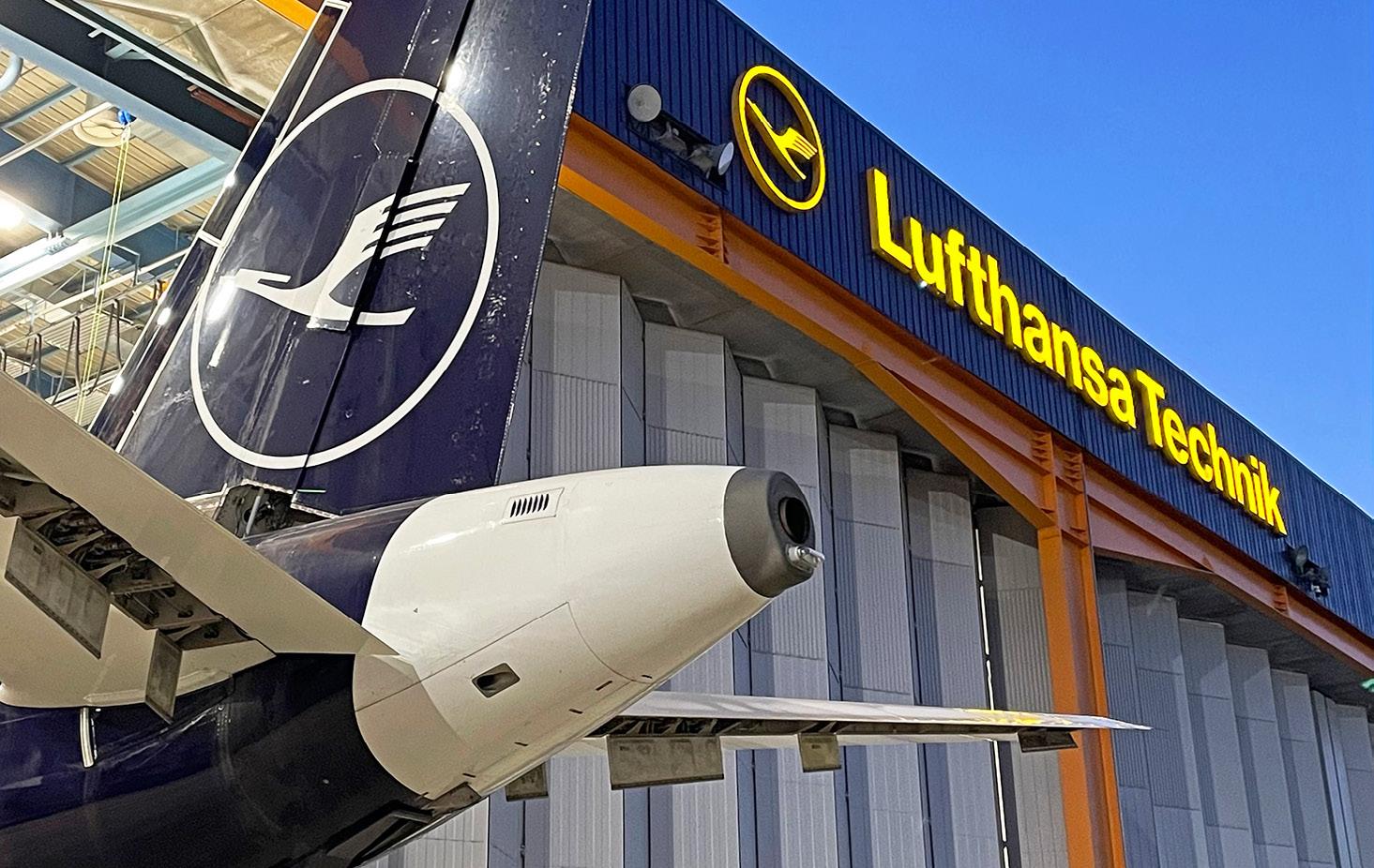
Baths are an inseparable part of the history of Budapest, which turns 150 this year, and it is worthily called the bath capital. The majority of tourists here include a visit to a bath during their stay. Budapest Spas operates the capital’s popular baths such as Rudas, known for its centuries-old Turkish bath, Europe’s largest bath palace, Széchenyi or the legendary Palatinus bath on Margaret Island. Recently, Gellért and Széchenyi were ranked among the 25 most beautiful baths in the world.
The balneological programs of Széchenyi bath are excellent for treating musculoskeletal complaints. In the Medical Spa department, medical treatments can be used without a referral, and can be recommended to anyone who wants to invest in their health.

www.szechenyimedicalspa.hu
“My focus is managing the company successfully. But even I can see that part of the routine programming work may be done by AI, freeing our programmers to do the more creative tasks. So, this is one of the big trends. And the question is, are we acknowledging it and really using it to our benefit? This could become a competitive advantage for an IT provider in any area, and just as much in aviation,” Neumann argues.

14 | 3 Focus www.bbj.hu Budapest Business Journal | October 6 – October 19, 2023
“My focus is managing the company successfully. But even I can see that part of the routine programming work may be done by AI, freeing our programmers to do the more creative tasks. So, this is one of the big trends. And the question is, are we acknowledging it and really using it to our benefit? This could become a competitive advantage for an IT provider in any area, and just as much in aviation.”
Continued from page 13 ›››
Stephan Neumann
German Companies Helping Hungary Move up the Value Chain
It seems German companies continue their love affair with Hungary. Their affection is also showcased by the data of the Hungarian Investment Promotion Agency, which has been busy guiding ambitious developments on Hungarian soil at its standard high frequency.
German investor activity shows no sign of diminishing, as evidenced by the statistics of Hipa. The 18-month period from 2022 through the first half of 2023 witnessed the closing of 29 deals worth more than EUR 2.1 billion to create more than 6,200 jobs. Not surprisingly, automotive was top of the chart, but pharma was also in the spotlight, not least thanks to Schott’s EUR 76 million investment to set up a new production site for pre-fillable syringes.
“Germany remains the strongest investor nation in Hungary, accounting for more than 21% of the total FDI stock. We are pleased that long-time clients such as Mercedes-Benz or Siemens decide to reinvest from time to time, and there are always new companies on the radar for whom Hungary appears as an investment location,” Hipa CEO István Joó says.
Indeed, the agency’s recent project pipeline has been full of Germanrelated announcements. To list but a few examples, automotive supplier Kirchhoff will invest EUR 50 mln to extend its capacities, Siemens’ new production hall broke ground in Budapest as part of a series of investments worth EUR 70 mln thru 2025, and Thyssenkrupp is boosting competitiveness by establishing new engineering capacities.
BMW Group’s new high-voltage battery assembly unit also deserves a mention. It will be added to the company’s iFactory site in Debrecen to support the on-site assembly of the fully electric Neue Klasse model generation.
Based on Hungarian Central Statistical Office data, close to 2,500 German-
owned businesses employ some 216,000 people all over the country. Hipa guided 187 related projects between 2014 and the first half of 2023 worth a combined EUR 9.5 bln.
Engineers Wanted
Among the most recent announcements from German businesses, many are concerned with upskilling and ramping up R&D competencies. Bosch is a prime example. About a year ago, after the Bosch Budapest Innovation Campus was inaugurated, the company broke ground on an R&D and testing hub next to the ZalaZone proving ground (234 km southwest of the capital by road), Hungary’s autonomous and 5G testing stronghold. The EUR 11.4 mln investment will provide work for 200 engineers in the fields of self-driving, e-mobility and artificial intelligence.
The latest announcement from the German giant came in early September and relates to a large-scale expansion of its plant for automotive components in Miskolc (185 km northeast of Budapest). The investment will strengthen the company’s development activities, including competencies and manufacturing infrastructure. It will also create even stronger synergies between product and process development activities and production areas.
In the R&D field, it will strengthen its activities in developing a new generation of eBike powertrains and the field of air conditioning motors, circulating pumps and valves for the automotive industry. The investment is worth EUR 12 mln and will create 60 new jobs. Of these, 45 will be reserved for highly educated staff.
In addition, the capacity of assembly lines for a new generation of several product types will be expanded, such as air conditioning blower motors, engine cooling
fans, and eBike drives. That latter part of the project will account for EUR 36 mln.
Celebrating its 30th anniversary in Hungary this year, Audi Hungaria Zrt. is increasingly thinking about knowledge-focused investments in line with the ever-expanding services activities it has been rendering in the past 15 years.
Value-added Subsidiary
Part of the not strictly productionrelated activities, such as procurement, IT and finance, have been transferred to Audi Hungaria Ahead Kft., a subsidiary founded earlier in February. The procurement team oversees strategic procurement, value engineering, supplier management, scouting and qualification.
The Győr-based IT experts provide a range of SAP, software development and DevOps (software development and IT operations) services for nearly 200 companies, while financial professionals assess and process accounts of some
10,000 suppliers and support the liquidity management of Audi AG.
Given that Audi Hungaria Ahead plans to increase its services volume heavily, it has announced a new Hipa-supported training program for its 500 staff who can participate in professional, nonprofessional and language courses in the next two years. The knowledge and competencies to be mastered are expected to boost company competitiveness in knowledge-based services.

“Alongside our manufacturing activities, we have systematically built up our service activities to keep pace with the transformation of the automotive industry and to adapt our business model to meet the challenges of the future,” Patrick Heinecke, director of finance, IT, procurement and compliance at Audi Hungaria and a member of the supervisory board of Audi Hungaria Ahead Kft. said at the announcement.
“Germany remains the strongest investor nation in Hungary, accounting for more than 21% of the total FDI stock. We are pleased that long-time clients such as Mercedes-Benz or Siemens decide to reinvest from time to time, and there are always new companies on the radar for whom Hungary appears as an investment location.”
“Audi Hungaria Ahead Kft. brings together our high value-added services in the areas of procurement, IT and finance, which create real added value for our customers. Our aim is to expand the range of services we provide to the Volkswagen Group by further enhancing the expertise of our employees,” he added.
Investor stories such as this all point in the same direction. German businesses are here to stay and typically aim to help their local operations move up the value chain. All of which is good news for Hungary.
bln
3 Focus | 15 www.bbj.hu Budapest Business Journal | October 6 – October 19, 2023
BBJ STAFF
PRESENTED CONTENT
Volume of Hipaguided German FDI Deals (2014-2023 H1) EUR 9.5
German-Hungarian Bilateral Trade (2022) +13.6%
y.o.y.
Hungarian Exports to Germany (2022) EUR 35.8 bln, +12.8% y.o.y.
German Imports to Hungary (2022) EUR 32 bln, +14.6% y.o.y.
Audi Hungaria, celebrating 30 years of business and investing in Hungary, has just set up a subsidiary here to handle procurement, IT and finance matters for Audi and, with time, the wider Volkswagen Group.
4Special Report
Energy
Szijjártó: Nuclear Power Could Mean More Energy Security for Hungary
[lead] time; for example, the production of the reactor jacket has already started in Russia,” shares Szijjártó.
The Hungarian minister also met with his Russian counterpart, Minister of Foreign Affairs of the Russian Federation Sergey Lavrov, on the sidelines of the United Nations General Assembly in New York on
Sep. 22.
In the statement issued by his ministry, Szijjártó says he reiterated Hungary’s position on the war in Ukraine at the meeting.
“I said that Hungary’s interest is for the war to end as soon as possible. I said that we Hungarians, too, are losing lives in this war, which is why we are pressing for an immediate ceasefire and the start of peace talks as soon as possible,” he emphasized.
According to Szijjártó, Lavrov offered assurances that Russia would continue to deliver “the contracted volume [of crude oil and gas] according to schedule” to Hungary and that “Russia would do the same for the nuclear fuel it supplies Hungary.”
“Nuclear energy is still under serious political and ideological attacks in Europe, although if we ask the question of how to produce electricity in large quantities at a competitive price, safely while protecting the environment, then nuclear energy is the solution,” Szijjártó declared at the 67th general assembly of the International Atomic Energy Agency (IAEA).
He added, “With the Paks expansion, Hungary will prevent the emission of 17 million tons of carbon dioxide annually. So, not only do we make the country more competitive, and not only do we guarantee the security of our energy supply, but we can also make a great contribution to the protection of the environment.”
Alexey Likhachev, CEO of the Russian nuclear energy company Rosatom, visited the Paks II project site (130 km south of Budapest by road) on Sep. 22, noting that “all obstacles to the Paks II project had been removed in the course of preparations and acquiring permits in the past years.” He added, “Hungarian companies would account for 40%

of the value added.”
Deputy Minister at the Ministry of Foreign Affairs and Trade Levente Magyar said the first concrete could be poured at the site in a year.
Following Likhachev’s visit to Paks, he met with Szijjártó at the IAEA assembly in Vienna. During Szijjártó’s discussions with Likhachev, he pointed out that there is ongoing consultation with Rosatom’s management regarding the investment.
National Interest
“Hungary’s national interest is to be able to use nuclear energy and to be able to do all this in cooperation with Rosatom. The investment in Paks is still a large international project; in addition to Rosatom, American, German and French companies are also involved,” Szijjártó argued.
The minister also commented on the possibility of sanctions from the European Union on the nuclear industry.
“We are constantly receiving news or rumors from Brussels that several European Union member states persistently keep the sanctioning of the nuclear industry on the agenda. This would seriously contradict Hungarian national interests, so, of course, if such a proposal were seriously to arise in the future, we would always veto it on the Hungarian side,” he emphasized.
According to Rosatom, Likhachev was equally bullish about the project’s future. “We thoroughly discussed with Minister Szijjárto the details of this project and issues related to import substitution since the sanctions policy of the West is also hitting this project, but nothing will stop
it. I am sure that it will develop at the proper pace and in the interests of the Hungarian people,” he was quoted as saying.
Szijjártó’s talks with Likhachev also centered around the progress of construction at the plant, highlighting that the length of the gap wall has now exceeded one kilometer, while a total of 2,700 meters
will be needed during the preparations for the construction of the power plant.
“We will be able to connect the two new blocks to the grid in the early 2030s, thereby greatly contributing to the security of the country’s energy supply and the availability of energy at an affordable price in Hungary,” Szijjártó stated.
Digging Deep
Extraction of the soil under the site of the future block six has begun, and the process is already underway at more than half a million cubic meters. Roughly half of the work has already been completed at the site, while excavation to a depth of five meters has already been completed at the site for reactor number five.
The next task will be soil consolidation, which will start on Nov. 1. At the same time, permits for soil extraction up to a depth of 23 meters will be prepared.
“Rosatom has already ordered the equipment with a long production
Szijjártó noted that Russia had already delivered 3.3 million tonnes of crude and 4.2 billion cubic meters of gas to Hungary this year.
Editor’s note: The Budapest Business Journal contacted the Hungarian Ministry of Foreign Affairs and Trade for further comment, along with consultancy firms Deloitte, KPMG and PwC, but by the time we went to press, they had not responded on the possible effects of the nuclear power plant on Hungary’s economy, energy security and environmental protection.
For more on this subject, see “Could Ukraine War Trigger a Meltdown for Paks 2 Project?” on page 18.
According to rosatomnewsletter. com, Hungary’s sole nuclear power plant was built and put into operation from 1982 to 1987 under the Paks NPP Construction Agreement signed in 1966. The Paks Nuclear Power Plant has four VVER440 reactor units with a total capacity of 1.9 GW. Since their service life was extended recently, they will remain operational until 2037. Rosatom adds that the Hungarian government is considering extending their life to 60 years.
www.bbj.hu Budapest Business Journal | October 6 – October 19, 2023
LUCA ALBERT
The construction of the additional nuclear power units at Paks is on schedule and on course to make Hungary a more competitive country while protecting the environment, Minister of Foreign Affairs and Trade Péter Szijjártó insisted in Vienna on Sep. 25.
From left, Deputy Minister at the Ministry of Foreign Affairs and Trade Levente Magyar, Gergely Jákli, CEO of Paks II NPP Ltd., and Alexey Likhachev, director general of Rosatom, and at the Paks 2 site.
Is Cabinet Mulling Action on Fuel Costs to Boost Growth?
While 2023 seems to be something of a write-off in terms of economic development for the government, the messaging generally conveys high hopes for the future. That will continue to rely on the auto sector and its switch to electric mobility. Currently, though, could the Hungarian economy strive for growth by potentially limiting fuel prices?
Hungary has been keen to sign deals with several, mostly Asian, investors on building battery and battery-component plants in locations throughout the country. This has sometimes proved controversial with local residents on environmental grounds, but the government has been consistent in its insistence that this is a crucial component for driving growth in the future.

Hungary’s economy, by all analytical projections, including those of the government and the National Bank of Hungary, will probably have to settle for 0% growth this year, while the optimistic upswing looking into 2024 and beyond hardly promises a rocket return to growth. In general, the blame for the issues that currently plague the country’s economy falls, for the most part, on energy prices. Inflation will likely reach a near 20%
annual average this year, recessionary risks will weigh on all sectors and the central bank, while observing its mandate, has no choice but to keep rates high.
As government officials frequently point out, the reason for all this is that Hungary, a landlocked country with little in the way of its own natural resources, relies on imports to keep the lights on. Until Jan. 24, 2022, the obvious choice
was Russia, but since it brought war back to Europe, reliance on the near neighbor to the east has proven to be ever more problematic at the EU level.
Prime Minister Viktor Orbán has stated that the country is exploring alternatives, mainly natural gas from Azerbaijan through a southern pipeline, the transmission of which could be facilitated through an as-yet-to-be-built network of interconnectors in the Central European Region.
The Makó Trough
The Hungarian government recently threw in ideas about dusting off earlier abandoned projects for domestically producing natural gas. While the easily accessible sources are not sufficient for its needs, the so-called Makó trough was estimated to hold enough natural gas to cover 150 years of domestic use but had previously been abandoned on the grounds that it was not economically viable to extract it from the ground.
Currently, based on all its communication channels, the government wants to realign economic growth to rely on consumption, with more value added taxes contributing to state coffers. The barriers to that are prices and inflation, which, given the country’s energy reliance, are primarily driven by the cost of fuel.
The government had already intervened once during the COVID period and introduced a mandatory cap on auto fuel prices that distorted market processes. Initially, drivers from neighboring countries were crossing the border to buy the cheaper fuel, spiking demand and draining supply. Over time, the cap was repeatedly amended and restricted until it was eventually dropped altogether.
Now, with the government’s declared intent to combat inflation and bring down costs, as Minister of Economy Development Márton Nagy has repeatedly stated, it seems fuel costs will once more come into regulatory focus.
Currently, based on all its communication channels, the government wants to realign economic growth to rely on consumption, with more value added taxes contributing to state coffers. The barriers to that are prices and inflation, which, given the country’s energy reliance, are primarily driven by the cost of fuel.
The government managed to upset many, apparently including those within its own ranks when it decided to revise the regulations on household solar panels. These costly investments were greatly encouraged, given that despite the initial outlay, they could make a household selfsufficient and, depending on how brightly the Sun shines, excess energy could be transferred into the main grid.
Unusual Clash
Unfortunately, it seems that the grid is not suited for the load. The suggestion was that an excess fee should be charged to homeowners with the
panels, but that would put them at a disadvantage despite their efforts and outlays. This triggered an unusual clash within a government famous for its party discipline when Máté Kocsis, a prominent member of Fidesz, challenged the ministry responsible for the decree to think again.
Without any specifics yet announced, there is speculation that there may well be a new state intervention in fuel prices, with the hope of encouraging growth and consumption.
For the time being, the state has limited options. With Minister of Finance Mihály Varga saying that Hungary is effectively pulling the plug on all centrally-financed ventures, the hopes of growth must fall on domestic household consumption.
Based on the fact that the current inflation rate (which is on a downward trend but still had Hungary in an unwanted position at the top of the EU podium at 16.4% in August) will edge close to 20% this year, and the main drive for that is food prices, there is hope to be found.
Food prices are still far from being cheaper than a year ago, but they are at least decelerating and possibly bottoming out. The sector is heavily reliant on transportation, and thus, fuel costs show a moderation in pricing.
Cabinet communication continues to blame inflation on the international costs of energy and raw materials, a space where Hungary has limited capacity to have a significant impact. The war in Ukraine will likely last way longer than anticipated, and the country’s transition to electricity is still a work in progress. The government may well feel intervening in fuel costs is one of the few levers it can pull.
4 Special Report | 17 www.bbj.hu Budapest Business Journal | October 6 – October 19, 2023
GERGŐ RÁCZ
Is another intervention on fuel on the cards in Hungary? Photo by Condas / Shutterstock.com
Best is yet to Come: New Incentives for BESS Projects on Horizon in Hungary
László Kenyeres Virág Lőcsei Partner Associate


Could Ukraine War Trigger a Meltdown for Paks 2 Project?
A recent legislative act in Hungary laid down the principles for the eagerly awaited battery energy storage systems (BESS) support scheme. The incentives follow well-known patterns similar to those already available for solar projects. However, is this enough to say that a transformative new approach to BESS investments is on hand, and what does this mean for interested stakeholders?
Based on Government Decree 382/2023 (VIII 14) of Hungary, the approach to electricity production and consumption from renewable energy sources has taken a new turn: BESS projects are now among those investments the government intends to support with financial incentives. The idea is to set up a contract for difference (CfD) based scheme that would reimburse investors or the Hungarian state, as applicable, for the difference between the prevailing market price and the strike price set under the subsidy, depending on how the market is performing (i.e., whether the market price is up or down compared to the strike price granted by the state budget).
A dedicated fund is expected to be established to finance the incentives, the details of which will be outlined in the forthcoming months. It seems at this point that, as with support schemes in the solar sector (the KÁT and Metár), expenses for the BESS incentives will be covered by the balance group operators in proportion to their electricity sales to end-users other than households and micro-businesses. In the end, however, it is more likely that these additional costs will be primarily borne by the participants in the free market, especially by industrial and commercial users. Compensation would be available not only to those feeding electricity into the public grid but also to single-user providers irrespective of their feed-in capacity and will be determined through a tendering process, again, similar to solar project support. The compensation will be calculated based on the difference between the claimed net revenue in the tender process (the strike price) and the reference net revenue the operator earns by selling its services (the market price). If the claimed net revenue is lower than the reference
net revenue, the transmission system operator, Mavir, would be obliged to pay the deficit to the investor. If the claimed net revenue exceeds the reference net revenue, the operator would receive compensation from the BESS owner. Other state support already granted, and the commissioning of waste recovery services will be considered reducing factors.
The detailed rules of the scheme (the calculation of the claimed net revenue and the reference net revenue, the eligibility criteria, and the accounting procedures) will be determined by the Hungarian Energy and Public Utility Regulatory Authority (MEKH) at the latest four weeks before the tender submission deadline. It appears that the compensation will be granted only up to 120 months after obtaining appropriate aFRR accreditation for the facility, with a cap to recover capital investments set at a minimum of EUR 16/kW and a maximum of EUR 160/kW per year. MEKH will revise the relevant benchmarks at least every two years, starting from 2027.
According to Mavir, the first tender is expected to be published in Q4 2023 and will remain open for about eight weeks, with a capacity of up to 400 MW available for investors. Due to recent changes to Mavir’s operational code, the transition of granted grid connections from photovoltaic power production to BESS projects will be allowed.
This new support scheme is expected to provide a necessary boost to electricity storage in Hungary. Facilities capable of storing electricity will play a significant role in shaping the future of the country’s energy landscape, given that they can ensure a consistent supply of electricity by storing excess energy when it is abundant and releasing it when needed, securing stability for the electricity grid. Market players interested in BESS projects must have up-to-date information and professional support when navigating these complex and earlystage environments. Legal guidance can ensure compliance and help adapt to this evolving market, ultimately contributing to the success of clients.
Despite the country’s commitment to electricity generation over emissionproducing fossil-based energy sources, the prospect of doubling Hungary’s nuclear energy output seems little closer. The expansion of the Paks power plant has seen many delays over the years. Were Russian financing of the venture to dry up due to sanctions over the war in Ukraine, it would surely be the project’s death knell.
An already troubled (and, if completed, eye-wateringly expensive) investment, the Paks 2 nuclear power plant project seems little closer to completion today than when it was announced almost 10 years ago, despite the very public statements of progress in the past few weeks. (For more on this, see page 16.)
Hungarian Prime Minister Viktor Orbán certainly produced a headlinecatching deal with Russia’s Vladimir Putin in 2014 when he announced the expansion of the power station at Paks (130 km south of Budapest by road). The agreement came without public consultation at the start of an election year that the PM’s Fidesz party comfortably won.
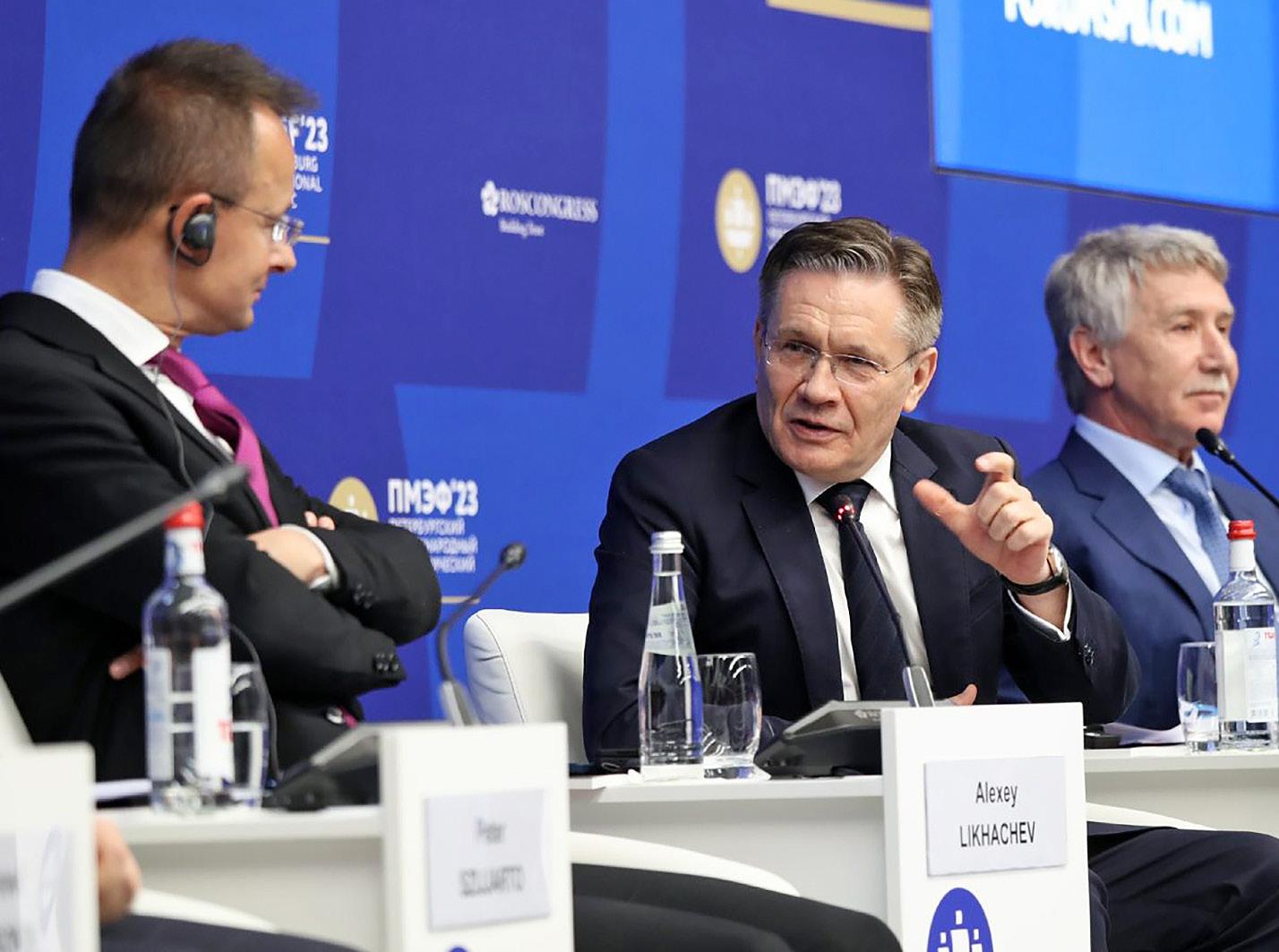
The Paks nuclear power plant produces approximately 40% of Hungary’s electricity. The expansion, adding two more reactors, was
deemed necessary since the end of the lifespan of the four existing units was within reach, while power demand in the country was rising and is set to grow further.
Indeed, on Dec. 7, 2022, the Hungarian Parliament voted to extend the operating life of the four tried and trusted Soviet-era VVER-440 reactors. According to Nuclear Engineering International, the units were originally due to have been decommissioned between 2032-37;
it is now assumed that they will work until at least 2052-57.
(Under Hungarian law, the decision to extend the life of the units did not require parliamentary approval, but the government decided to consult the deputies – most of whom belong to its two-thirds majority – on this issue, given what it said was the great importance of the matter.)
18 | 4 Special Report www.bbj.hu Budapest Business Journal | October 6 – October 19, 2023
NOTE: ALL ARTICLES MARKED INSIDE VIEW ARE PAID PROMOTIONAL CONTENT FOR WHICH THE BUDAPEST BUSINESS JOURNAL DOES NOT TAKE RESPONSIBILITY
WOLF THEISS BUDAPEST
INSIDE VIEW
WOLF THEISS BUDAPEST
www.wolftheiss.com
GERGŐ RÁCZ
Hungarian Minister of Foreign Affairs and Trade Péter Szijjártó (left) and Rosatom Director General Alexey Likhachev (center) at an event this summer. Photo by Rosatom.
The government has repeatedly stated the importance of focusing more on nuclear as a carbon-free alternative capable of delivering with today’s technology. Ironically, given the deep level of Russian involvement in Paks 2, the war has been repurposed as another reason for pressing ahead.
“We have once again extended the life of the existing power units of the Paks nuclear power plant,” the Hungarian government said on its Facebook page last December.
“Energy prices during the war and problems with the energy supply of Europe have also affected Hungary,” it noted.
Sustainable Energy
Most opponents of the project have long been against nuclear power due to its environmental impact and risks. The accident at the Fukushima Daiichi power plant in Ōkuma, Japan, in March 2011 was still fresh in the memory in 2014. It prompted Germany, famously, to announce the closure of its plants, a process that was only completed on April 15 of this year. Still, the Hungarian government has stood by its plans, saying it is a green and sustainable energy source that doesn’t produce harmful emissions.
The venture has, however, proven problematic, as evidenced by its implementation contract being revised six times since pen was first put to paper.
A crucial element of the package signed in 2014 was not only that Paks 2 would be built with Russian technology, but that the project financing would also come from a Russian loan deal.
The latest revision on the execution of the project was signed in August of 2023, with Minister of Foreign Affairs and Trade Péter Szijjártó once more insisting the project was a crucial national strategic interest.
By then, the first new powergenerating unit was already supposed to be in operation, with the other additions coming in
2025-2026.
However, the project continues to suffer from delays in implementation, not least for ecological reasons; it was discovered it would be built at a location that might be affected by earthquakes, and precautionary measures were therefore required.
From a practical perspective, the deal signed also states that the nuclear waste from the plant would go to Russia. Domestically, the venture was challenged because these terms weren’t properly clarified in the government license issued to execute construction.
All this seems even more problematic, given how sanctions have cut off almost all trade with Russia, and the severity of the measures implemented by the European Union look likely to be lasting and, if anything, to escalate.
Financing Questions
As indicated above, 80% of the EUR 12 billion budget for the investment was to be financed by Russia. The duration of the loan was originally set at 30 years with an interest rate of 4-5%.
Over the many years of delays, the Hungarian government has been criticized for not choosing Scandinavian or South Korean technology suppliers, among other things, but the financial terms of the project have been a particular area of scrutiny.
Among the many modifications of the contract, in June 2021, Parliament approved a revision of the financing contract, extending the duration of the agreement so that the necessary installments would only become due after the launch of the facility, now planned for 2031.
Russia’s invasion of Ukraine and the resulting sanctions have put, at the very least, a question mark over the finances and whether the project can be built under the original conditions. Hungary has repeatedly and forcefully said it will not tolerate any EU sanctions that touch on nuclear power, insisting that it is a matter of national sovereignty. However, under the initial agreement, the government was to finance
EUR 2 bln
Minister of Finance Mihály Varga announced that, for the sake of the state budget, the government is suspending a range of projects, even those underway. This is necessary for Hungary to reach the 2.9% deficit target based on Maastricht criteria next year. The 2023 gap is already more significant than planned, with no growth foreseeable this year to compensate.
After the latest modification of the Paks 2 contract in August, Rosatom has finally started fieldwork on the site, after what officials describe as the preparatory stage. The Russian company and its main Hungarian sub-contractor, Duna Aszfalt Zrt., have started moving one billion cubic meters of dirt and establishing the main facilities.
Critics point out that even this may be an exercise in pointlessness. Given the overall financing of the project, the limitations on Russian sources that, since the invasion of Ukraine are very much in doubt, and there are legal challenges against the venture both on environmental and contractual grounds, there are many more hurdles yet to come.
A change in government seems unlikely in the foreseeable future, but opposition parties have repeatedly stated that they would shut down the Paks 2 investment and concentrate instead on a more decentralized power grid development.
Tax Incentives for Corporate Environmental Protection, Energy Efficiency Investments
Judit Jancsa-Pék Partner, Senior tax advisor

Hungary provides various tax incentives, including discounts and subsidies for environmental protection and energy efficiency investments. However, the conditions and rules for obtaining these are subject to change, so it is highly advisable to carefully consider maximizing tax savings before starting any development.
The National Energy Strategy and the EU Green Deal stipulate and boost investments in energy efficiency and the transition to alternative energy sources. Thanks to these incentives, we are witnessing the proliferation of solar parks and rooftop panels, the growing popularity of electric cars, and Hungary’s ambitious pursuit of a global leadership role in battery manufacturing.
One of the simplest ways to finance a sustainability investment is the creation of a development reserve tax credit to reduce the corporate income tax base. The given year’s profit must be set aside into the tied-up reserve and used for investments in the following four tax years: 100% of the pre-tax profit can be used for such aim without an upper limit.
Furthermore, an additional temporary tax incentive became available in the corporate income tax system as of July 15 for investments of strategic importance in the transition to a net zero economy. The support must be assessed by Dec. 31, 2025.
The maximum support intensity is 15% in Budapest and 35% outside the capital, but it can be increased by 10% for medium-sized enterprises and 20% for small enterprises at national level.
The development tax allowance incentive may be used for investments in producing batteries, solar panels, wind turbines, heat pump equipment and related components.
Development tax allowances may also facilitate the financing of environmental investments. This is a direct credit from the payable corporate income tax itself, determined by considering the present value of the eligible costs of the investment and an EU conform intensity rate. The support may differ depending on the size of the enterprise and the location of the investment. A 1.8% effective CIT rate is available, which can be used for 13 tax years, but at the latest, by the end of the 16th tax year from the start of the investment. To activate the subsidy, prior notification is required, and it is mandatory to operate the completed investment for a specified period. In the case of an independent environmental protection investment, the entitlement limit is HUF 100 million at present value. The entitlement thresholds are even more favorable for SMEs.
Another option, the energy efficiency tax credit, may be used up to 70% of the calculated tax. Depending on the applicable intensity rates, a maximum tax saving of 45+20% of the eligible investment costs may be achieved, up to EUR 15 million. The credit may be utilized in six tax years, and the investment must be operated for at least five years. The advantage is that the central Hungarian region is also subsidized, but only one of either the development tax allowance or the energy efficiency tax credit may be applied to the same investment.
Finally, it is worth mentioning that an incentive for establishing an electric charging station is also available as a reduction from the tax base for the total purchase investment value, on the condition that the respective CIT saving falls under the so-called de-minimis subsidies.
If you plan an environmental protection or energy efficiency investment, you should assess the available tax incentives. Preparation and administration of feasibility studies, tax optimization calculations, tax allowance claims, subsidy documentation and specific audits need professional support.
You may rely on LeitnerLeitner’s specialized full-scope tax incentive service package. LeitnerLeitner is one of Central Europe’s most influential tax, accounting, audit and legal consulting companies, with global coverage through the Taxand and Praxity networks.
4 Special Report | 19 www.bbj.hu Budapest Business Journal | October 6 – October 19, 2023
NOTE: ALL ARTICLES MARKED INSIDE VIEW ARE PAID PROMOTIONAL CONTENT FOR WHICH THE BUDAPEST BUSINESS JOURNAL DOES NOT TAKE RESPONSIBILITY
INSIDE VIEW
LeitnerLeitner www.leitnerleitner.com
of the investment; right now, even that seems questionable, at least in the short term.
The Benefits and Risks AI Brings to the Energy Sector
Dr. Róbert Szuchy Managing Partner
Artificial Intelligence is rapidly transforming the energy sector. Its capabilities, ranging from predictive maintenance and demand forecasting to renewable energy optimization and grid management, are revolutionizing how we understand and manage energy.

For instance, by analyzing data from sensors, AI can predict when equipment like wind turbines might fail, ensuring maintenance occurs during scheduled downtimes rather than causing unexpected interruptions.
At the same time, AI’s ability to analyze vast amounts of data, including weather patterns and historical usage, allows for more accurate energy demand forecasting. Artificial intelligence can be used in many areas of the energy sector.
Forecasting and Optimization: AI’s predictive analytics capabilities are crucial in accurately forecasting energy production from variable sources like solar and wind. Machine learning models trained on historical and real-time data can predict energy generation trends with high precision, accounting for weather conditions, seasonal variations, and other factors. Accurate predictions enable efficient grid management and energy distribution, ensuring the generated power meets demand without significant wastages or shortfalls.
Predictive Maintenance: Renewable energy infrastructure, including wind turbines and solar panels, requires regular maintenance to operate optimally. AI-driven predictive maintenance algorithms analyze data from sensors to identify wear and tear, mechanical issues, or other maintenance needs before they escalate into significant problems. This proactive approach reduces operational downtimes, extends equipment lifespan, and lowers maintenance costs.
Energy Storage: Energy storage is a critical aspect of managing the intermittency and variability of renewable energy. AI algorithms optimize energy storage systems, ensuring excess generated energy is efficiently stored for later use. By predicting demand
patterns and energy generation trends, AI enables the dynamic allocation of stored energy to meet demand, enhancing the reliability of renewable energy sources.
Load Forecasting: AI’s role in load forecasting is instrumental in enhancing the adaptability of renewable energy systems. By predicting the energy demand at granular levels, AI aids in the strategic placement of energy resources, efficient energy distribution, and mitigating overloads or deficits. This ensures that renewable energy resources are utilized to their fullest potential to meet varying energy demands.
Challenges and Opportunities
Despite the significant prospects, integrating AI in the renewable energy sector is not without challenges. Data privacy, security, and ethical considerations need paramount attention. There is a need for regulatory frameworks to ensure the responsible and equitable deployment of AI technologies.
Nevertheless, the opportunities far outweigh the challenges. AI’s scalability, adaptability, and precision are indispensable for the largescale adoption of renewable energy. As artificial intelligence technologies evolve, they are expected to unlock new frontiers in renewable energy, driving innovations, reducing costs, and contributing significantly to global sustainability goals.
However, AI systems in the energy sector often rely on vast amounts of data to optimize operations, predict maintenance, and enhance service delivery. While this datadriven approach is beneficial, it raises significant concerns about data privacy and security. There’s a risk of unauthorized entities accessing, manipulating, or stealing sensitive data, leading to financial, reputational, and legal repercussions.
The amalgamation of AI and energy is a pivotal development in the quest for sustainable and efficient energy systems. By enhancing prediction, optimization, maintenance, storage, and grid integration, AI accelerates the realization of a world powered predominantly by clean and renewable energy. Collaborative efforts among stakeholders, including technology developers, energy providers, policymakers, and consumers, will be vital to maximizing the potential and addressing the challenges of this convergence.
Energy
in Brief News
Hungary, Slovakia Sign Nuclear Energy Cooperation Agreement
Hungary and Slovakia signed an agreement on cooperation in the nuclear energy industry Sep. 27, according to state news agency MTI. The deal was signed by Minister of Foreign Affairs and Trade Péter

Szijjártó and Slovakian Minister of Economy Peter Dovhun in Bratislava. Szijjártó said the main aim is to harmonize the countries’ participation in nuclear energy developments.
Lantos: District Heating Fees Halved From October
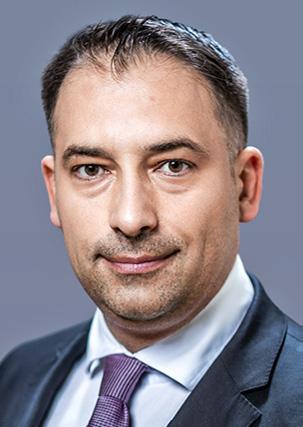
District heating fees for local governments, public institutions and businesses will be halved from October, Minister of Energy Csaba Lantos said on Sep. 29, according to uzletem. hu [My Business]. Lantos noted that district heating fees for non-household consumers had already been halved in January. He added that the new reduction means fees will be onequarter of those at the end of last year.
MVM Zöld Building HUF 9.7 bln Solar Park
MVM Zöld Generáció, the renewables unit of state-owned energy company MVM, is building a HUF 9.7 billion solar park in Kecskemét (95 km southeast of Budapest), government and company officials announced on Sep. 27, according to portfolio.hu. The 23.8 MW park, to be completed by year-end, will have the capacity to power more than 12,000 homes. European Union funding is covering HUF 4 bln of the project cost.
Corvinus Uni, ExxonMobil Sign Cooperation Agreement
Corvinus University of Budapest and ExxonMobil Hungary signed a strategic agreement on Sep. 28. The main goal of the cooperation between the school and the local unit of energy company ExxonMobil is to forge closer ties between the business and
education-research sectors to advance their mutual development. Under the deal, ExxonMobil Hungary’s top managers will give presentations and hold seminars at the university. From the spring semester, Corvinus students will be able to participate in projects involving ExxonMobil Hungary. Corvinus will also offer ExxonMobil Hungary’s managers training at its Seed Executive School.
LMP Calls on Minister of Energy to Resign
Green opposition party LMP [Politics can be Different] is calling on Minister of Energy Csaba Lantos to resign as it says a government decree that came into effect on Sep. 22 favors polluting and environmentally destructive companies, according to a video message posted on Facebook. László Lóránt Keresztes, a member of LMP and the chairman of the Parliamentary Sustainable Development Committee, said in the video message posted on Sep. 24 that, citing the wartime emergency, the government put into effect a decree that allows “polluting and environmentally destructive companies to avoid fines, and which makes it impossible to close plants in the event of serious environmental pollution.” Keresztes said LMP has already announced that it will turn to the Constitutional Court of Hungary because of the “destruction” of the environmental protection institutional system. Keresztes said “the licensing procedure for dangerous industrial plants and battery factories is chaotic.”
Orbán Meets Veolia Chairman
Prime Minister Viktor Orbán met with Antoine Frerot, the chairman of France’s Veolia, at his office in the capital on Sep. 26, the PM’s press chief Bertalan Havasi said, according to origo.hu. The parties discussed updating the strategic partnership agreement between the government and Veolia’s Hungarian unit signed 10 years earlier. They also spoke about Veolia’s plans in Hungary, including power plant investments.
20 | 4 Special Report www.bbj.hu Budapest Business Journal | October 6 – October 19, 2023
INSIDE VIEW
www.bslaw.hu
NOTE: ALL ARTICLES MARKED INSIDE VIEW ARE PAID PROMOTIONAL CONTENT FOR WHICH THE BUDAPEST BUSINESS JOURNAL DOES NOT TAKE RESPONSIBILITY
BSLAW BUDAPEST
Photo by lovelyday12 / Shutterstock.com
Ranked by total net revenue in 2022
(20) 459-9600 versenypiac@audaxrenewables.hu
3700 Kazincbarcika, Bolyai tér 1. (48) 511-816 energiaker@borsodchem.eu
1061 Budapest, Liszt Ferenc tér 5. (1) 240-7504 ptakacs@energiakereskedo.hu
Briglovics, Hana Lindovská, Péter Vámos
1085 Budapest, Kálvin tér 12. (1) 886-3400 admin.hun@alpiq.com
4 Special Report | 21 www.bbj.hu Budapest Business Journal | October 6 – October 19, 2023
E lectricity Traders
RANK COMPANY WEBSITE TOTAL NET REVENUE IN 2022 (HUF MLN) TYPES OF ENERGY TRADED Y EA R ES T ABLIS H ED OWNERSHIP (%) HUNGARIAN NON-HUNGARIAN TOP LOCAL EXECUTIVE ADDRESS PHONE EMAIL E LE CTR I C I T Y GAS O IL COAL E MISSION C E RT I F I C A T E 1 MVM PARTNER ENERGIAKERESKEDELMI ZRT www.mvmp.hu 2,691,524 ✓ ✓ – – ✓ 2002 MVM Energetika Zrt. (100) –Gábor Orbán 1031 Budapest, Szentendrei út 207–209. (1) 304-2000 info@mvmp.hu 2 MVM NEXT ZRT www.mvmnext.hu 2,252,494 ✓ – – – – 2019 MVM Energetika Zrt. (100) –Gábor Hiezl 1081 Budapest, II. János Pál pápa tér 20. (1) 474-9999 gyfelszolgalat@mvm.hu 3 E ON ENERGIAMEGOLDÁSOK KFT www.eon.hu 788,883 ✓ – – – – 2004 E.ON Hungária Energetikai Zrt. (100) –Balázs Lehoczki 1134 Budapest, Váci út 17. 20/30/70/ 459-9600 eon@eon.hu 4 AUDAX RENEWABLES KFT https://audaxrenewables.hu/ 315,464 ✓ – – – – 2013 –Audax Renovables S.A. (100) Tibor István Fejes 1139 Budapest, Fiastyúk utca 4–8.
BC-ENERGIAKERESKEDŐ KFT www.bcenergia.com 296,684 ✓ ✓ – – – 2004 BorsodChem Zrt. (100) –Sándor
5
Varga
6 BUDAPESTI ENERGIAKERESKEDŐ KFT www.energiakereskedo.hu 4,792 ✓ – – – ✓ 2003 Péter Takács (100) –
Péter Takács
NR ALPIQ ENERGY SE MAGYARORSZÁGI FIÓKTELEPE www.alpiq.ch A ✓ ✓ ✓ ✓ ✓ 2009 –Invidivuals (100)
Gábor
Fuel Retail Companies
Ranked by total net revenue in 2022
(1) 436-3200 info-hu@shell.com
2040 Budaörs, Sport utca 2–4. (23) 886-200 info@auchan.hu
1016 Budapest, Mészáros utca 58/B (1) 450-2960 mabanaft@mabanaft.hu
1185 Budapest, Liszt Ferenc Nemzetközi Repülőtér
22 | 4 Special Report www.bbj.hu Budapest Business Journal | October 6 – October 19, 2023
RANK COMPANY WEBSITE TOTAL NET REVENUE IN 2022 (HUF MLN) YEAR ESTABLISHED NO. OF FULLTIME EMPLOYEES ON JULY 1, 2023 OWNERSHIP (%) HUNGARIAN NON-HUNGARIAN TOP LOCAL EXECUTIVE ADDRESS PHONE EMAIL 1 MOL MAGYAR OLAJ- ÉS GÁZIPARI NYRT www.mol.hu 3,858,458 1991 5,372 Hungarian State (25.20), other (24.50) Foreign investors (34.80), other (15.50) Zsolt Hernádi 1117 Budapest, Október huszonharmadika utca 18. (1) 209-0000 ugyfelszolgalat@mol.hu 2 TESCO-GLOBAL ÁRUHÁZAK ZRT www.tesco.hu 723,303 1989 10,195 –Tesco Holdings B.V. (100) Zsolt Pálinkás 2040 Budaörs, Kinizsi út 1–3. (20) 827-0000 tescoglobalzrt@ hu.tesco-europe.com 3 OMV HUNGÁRIA ÁSVÁNYOLAJ KFT www.omv.hu 656,850 1990 62 –OMV Downstream GmbH (100) Tibor Balogh 1117 Budapest, Október huszonharmadika utca 6–10. (1) 381-9700 info.hungary@omv.com 4 SHELL HUNGARY KERESKEDELMI ZRT www.shell.hu 446,668 1989 101 –Shell Petroleum N.V. (100) Andrea Solti Istenesné 1113 Budapest, Bocskai út 134–146.
5 AUCHAN MAGYARORSZÁG KERESKEDELMI ÉS SZOLGÁLTATÓ KFT www.auchan.hu 354,075 2004 5,982 –AUCHAN
A)
Retail International S.A. (A), Valhungary International SCA (
Gergely Polgár Viktória Lucenko
6 NORMBENZ MAGYARORSZÁG KFT www.orlen.hu 83,110 2003 719 –UNIPETROL RPA s.r.o. (100) Jenő Horváth-Dori Jaroslaw Przemyslaw Szeliga István Nagy
7 MABANAFT HUNGARY KERESKEDELMI KFT www.mabanaft.hu 71,167 2001 10 –Mabanaft GmbH & Co KG (100) Lajos Alács
1068 Budapest, Benczúr utca 13. (1) 465-7600 info@normbenz.hu
8 RÜK REPÜLŐTÉRI ÜZEMANYAG KISZOLGÁLÓ KFT –68,880 2005 39 Budapest Airport Zrt. (100) –Tamás Dékány
9 ORLEN UNIPETROL HUNGARY KFT www.orlen.hu 65,613 2015 8 –ORLEN Unipetrol RPA s.r.o. (100) Ernő Kovács-Tarsoly Tímea Szentkereszty-Tarjányi
Budaörs,
12.
10 LUKOIL LUBRICANTS EUROPE GMBH MAGYARORSZÁGI FIÓKTELEPE www.lukoil.hu 43,120 (2021) 2003 2 –Oleg Tolochko (100) Tomas Ribanszky 1138 Budapest, Népfürdő utca 22. (1) 465-7600 Oleg.Tolochko@lukoil.com 11 MO-TO '95 KFT https://mo-to95.hu/ 36,172 1995 59 Individuals (100) –Attila Hoffer Gyula Zsolt Hoffer 9028 Győr, Őrhely út 7. (96) 437-029 office@mo-to95.hu 12 J UND J KFT www.maxiline.hu 13,826 1996 89 Individuals (100) –János Pajkos 4030 Debrecen, Galamb utca 2–4. (52)
13 GROVI KFT www.grovi.hu 10,194 1994 42 (100) –Tibor Vizler Andrea Vámosi Vizlerné 4300 Nyírbátor, Szentvér utca 41. (42) 510-288 postmaster@grovi.t-online.hu 14 FULL-SOPRON KERESKEDELMI ÉS SZOLGÁLTATÓ KFT www.full-sopron.hu 8,919 2004 49 Individuals (100) –Csaba Bognár Péter Csapó Csaba Vasi 9330 Kapuvár, Ipartelepi út 8. (96) 595-250 fullsopron@t-online.hu 15 MPH POWER ZRT www.mobilpetrol.hu 4,380 2001 2 (100) –Anna Mária Papp Lázárné 1095 Budapest, Ipar utca 2/A (20) 400-6373 info@mobilpetrol.hu 16 ENVIROCHEM KFT www.envirochem.hu 1,416 1995 7 Gábor Egri (65), Adrienne Bakos (35) –Gábor Egri 1225 Budapest, Nagytétényi út 221–225. (1) 391-0570 mail@envirochem-ltd.com
(1) 296-5107 companysecretary@bud.hu
2040
Puskás Tivadar utca
(1) 465-7600 nfo@normbenz.hu
470-519 jundj@t-online.hu
Gas Traders
Ranked by total net revenue in 2022
4 Special Report | 23 www.bbj.hu Budapest Business Journal | October 6 – October 19, 2023
RANK COMPANY WEBSITE TOTAL NET REVENUE IN 2022 (HUF MLN) YEAR ESTABLISHED NO. OF FULL-TIME EMPLOYEES ON JULY 1, 2023 OWNERSHIP (%) HUNGARIAN NON-HUNGARIAN TOP LOCAL EXECUTIVE ADDRESS PHONE EMAIL 1 MVM NEXT ENERGIAKERESKEDELMI ZRT www.mvmnext.hu 2,252,494 2019 369 MVM Energetika Zrt. (100) –Gábor Hiezl 1081 Budapest, II. János Pál pápa tér 20. (1) 474-9999 ugyfelszolgalat@mvm.hu 2 MET MAGYARORSZÁG ENERGIAKERESKEDŐ ZRT https://hugas.met.com 398,108 2007 56 –MET Sales and Trading Holding AG (100) Gergely Szabó 1117 Budapest, Dombóvári út 26. (1) 464-1111 info.methu@met.com 3 AUDAX RENEWABLES KFT https://audaxrenewables.hu/ 315,464 2013 194 –Audax Renovables S.A. (100) Tibor István Fejes
Budapest, Fiastyúk utca 4–8. (20) 459-9600 versenypiac@ audaxrenewables.hu 4 OPUS TIGÁZ ZRT www.tigaz.hu 42,653 1993 801 –MS Energy Holding Zrt. (100) Balázs Torda
Hajdúszoboszló, Rákóczi utca 184. (52) 558-100 ugyfelszolgalat@tigaz.hu 5 PRÍMAENERGIA ZRT www.primaenergia.hu 32,740 1991 280 "HO-ME 2000" Vagyonkezelő Kft. (100) –Zoltán Szirmai 1117 Budapest, Alíz utca 3. (1) 209-9900 vevoszolgalat@primaenergia.hu 6 FLAGA HUNGARIA KFT www.flaga.hu 24,229 1990 108 –Zentraleuropa LPG Holding GmbH (100) Kinga Bodó Réka Várkonyi Kantiné 2040 Budaörs, Puskás Tivadar utca 14. (23) 507-600 flaga@flaga.hu 7 MVM CEENERGY ZRT https://ceenergy.hu/ 5,584 2000 121 MVM Energetika Zrt. (100) –László Zoltán Fritsch
Budapest, Váci út 144–150. (20) 597-0000 info@ceenergy.hu
1139
4200
1138
24 | 4 Special Report www.bbj.hu Budapest Business Journal | October 6 – October 19, 2023 Universal Electricity Providers Ranked by total net revenue in 2022 Universal Gas Providers Ranked by total net revenue in 2022 RANK COMPANY WEBSITE TOTAL NET REVENUE IN 2022 (HUF MLN) YEAR ESTABLISHED NO. OF FULL-TIME EMPLOYEES ON JULY 1, 2023 OWNERSHIP (%) HUNGARIAN NON-HUNGARIAN TOP LOCAL EXECUTIVE ADDRESS PHONE EMAIL 1 MVM NEXT ZRT www.mvmnext.hu 2,252,494 2019 369 MVM Energetika Zrt. (100) –Gábor Hiezl 1081 Budapest, II. János Pál pápa tér 20. (1) 474-9999 ugyfelszolgalat@mvm.hu 2 E ON ENERGIAMEGOLDÁSOK KFT www.eon.hu 788,883 2004 357 E.ON Hungária Energetikai Zrt. (100) –Balázs Lehoczki 1134 Budapest, Váci út 17. (20/30/70) 459-9600 eon@eon.hu 3 AUDAX RENEWABLES KFT https://audaxrenewables.hu/ 315,464 2013 194 –Audax Renovables S.A. (100) Tibor István Fejes 1139 Budapest, Fiastyúk utca 4–8. (20) 459-9600 versenypiac@ audaxrenewables.hu RANK COMPANY WEBSITE TOTAL NET REVENUE IN 2022 (HUF MLN) YEAR ESTABLISHED NO. OF FULL-TIME EMPLOYEES ON JULY 1, 2022 OWNERSHIP (%) HUNGARIAN NON-HUNGARIAN TOP LOCAL EXECUTIVE ADDRESS PHONE EMAIL 1 MVM NEXT ZRT www.mvmnext.hu 2,252,494 2019 369 MVM Energetika Zrt. (100) –Gábor Hiezl 1081 Budapest, II. János Pál pápa tér 20. (1) 474-9999 ugyfelszolgalat@mvm.hu 2 ALPIQ CSEPEL KFT www.csepel.alpiq.hu 222,906 2001 A –Alpiq AG (100) Gábor Briglovics, Csaba Varga, Balázs Bene 1085 Budapest, Kálvin tér 12. (1) 429-1030 info.csepel@alpiq.com 3 OPUS TIGÁZ ZRT. www.tigaz.hu 42,653 1993 801 –MS Energy Holding Zrt. (100) Balázs Torda 4200 Hajdúszoboszló, Rákóczi utca 184. (52) 558-100 ugyfelszolgalat@tigaz.hu 4 OERG ÓZDI ENERGIASZOLGÁLTATÓ ÉS KERESKEDELMI KFT www.oerg.hu 175 1993 19 Ózd Industrial Park Kft. (A), Fémiksz Kft. (A) –Imre Kovács, Péter Miksztaj 3600 Ózd, Gyár út 1. (48) 574-399 oerg@oerg.hu A = would not disclose, NR = not ranked, NA = not appliacable This list was compiled from responses to questionnaires received by October 4, 2023, and publicly available data. To the best of the Budapest Business Journal’s knowledge, the information is accurate as of press time. The list is based on companies’ voluntary data submissions. While every effort is made to ensure accuracy and thoroughness, omissions and typographical errors may occur. Additions or corrections to the list should be sent on letterhead to the research department, Budapest Business Journal, 1075 Budapest, Madách Imre út 13–14, or faxed to (1) 398-0345. The research department can be contacted at research@bbj.hu
5 Socialite
Smile, You’re in Hungary Now!
In 1987, after DJ Danny Rampling had seen the musical light in Ibiza, he set up his revolutionary club Shroom on the island. Smiley became the club’s mascot. Rampling told writer Luke Bainbridge, “I picked up on the smiley face logo from a fashion designer called Barnsley. I ran into him one night when he was covered in these smiley face badges, and I thought, ‘Wow! That’s it.’ The smiley face completely signifies what this movement is about: big smiles and positivity.”
Other clubs began using a modified Smiley, and when acid house went above ground in the United Kingdom around the middle of 1988, he became ubiquitous all over again.
In 1988, Smiley became an emoji. Shigetaka Kurita, an employee of Japanese telco NTT Docomo, “hit on the idea of adding simplistic cartoon images to its messaging functions as a way to appeal to teens,” wrote Adam Sternbergh in New York magazine. Smiley was one of them.
For what it’s worth, I’d always assumed that Nirvana’s adoption of a warped Smiley was a reaction to acid house and inane emojis. But apparently, it’s meant to suggest the warped state of Nirvana that listening to the band can take you to.
The French Smiley
World Smile Day is the brainchild of Harvey Ball, a commercial artist from Worcester, Mass., who created the internationally recognized bright yellow smiley face in 1963. In 1999, worried that Smiley had become too commercialized, Ball announced that the first Friday in October would become National Smile Day, devoted to, as the Harvey Ball World Smile Foundation website puts it, “smiles and kind acts throughout the world.”
Smiley came about when the State Mutual Life Assurance Company had a morale problem after it purchased Guarantee Mutual Company of Ohio to join forces with Worcester Mutual Fire Insurance Company, which State owned. The company asked graphic artist Ball to create a smile to be used on buttons, desk cards and posters.
It took him 10 minutes to create Smiley, and he was paid
USD 240,
all he ever received for his creation. Mind you, that was better than some feared. Writing in Smithsonian Magazine, Jimmy Stamp claimed that Ball was only paid USD 45.
In time, Worcester Mutual Fire Insurance morphed into the Worcester Insurance Company, which still uses Smiley in its marketing.
Previous smileys may have inspired Ball. In a fascinating online article, the U.K. graphic designer Paul Hillery suggests that the image of a smiling face with slashes for eyes and mouth dates back centuries before the birth of Christ.
A smiling face that looks a lot like Smiley was part of the logo for the early 1960s U.S. TV show “The Funny Company.” In 1962, a New York radio station gave away thousands of sweatshirts featuring a funky image that looks very much like Smiley with the slogan “WMCA good guy.” (DJs at WMC were known as the Good Guys.) Hillery has even tracked down an image of Mick Jagger wearing one of these yellow smiling face sweatshirts.
The Spain Smiley
In 1970, Philadelphia brothers and novelty goods manufacturers Bernard and Murray Spain began making Smiley buttons with the phrase “Have a nice day.” By 1972, 50 million had been sold. Jon Savage wrote in The Guardian, “That wasn’t all. There was an eruption of Smiley ephemera. [….] The Smiley was the perfect
feel-good symbol of a moment when 1960s ideas of freedom, hedonism and experimentation hit the American masses.”
Wearing a Smiley button was also highly likely to have originally been a secret badge of hipness associated with ingesting certain substances likely to mellow one out. In the early 1970s, barely into my teens, I had a Smiley patch sewn onto my denim jacket. I must have seen an older hippy type and thought it was seriously cool.
Because of these associations, Smiley reappeared around the time of what’s called the Second Summer of Love, the period in the late
1980s
when rave culture and acid house exploded in the United Kingdom before spreading throughout the world.
No doubt to their everlasting chagrin, the Spain brothers didn’t trademark Smiley. That was done by French journalist Franklin Loufrani, founder of the Smiley Company. In 2017, the company, based in Britain, was responsible for 210 million products. Smiley had 97% recognition globally.
I did ask my Hungarian partner, a Nirvana fan, if she remembers Smiley from her childhood growing up in the communist era, but she doesn’t. Presumably, although Smiley went global, he (she, they?) didn’t make it inside the Soviet Bloc. This could have something to do with Hungarian attitudes to smiling.
When I first came to Hungary, my partner and I frequently visited our local sauna. Being a polite Brit, used to smiling my way into (and sometimes out of) any situation, I would smile as I climbed into the cabin. At some point, unable to stand it anymore, my partner hissed, “Don’t smile! They think you’re stupid. Hungarians don’t smile for no reason.”
Although I was a little insulted at the time, I have come to appreciate the fact that if I don’t want to smile out of politeness, I don’t have to. Hungarians save their smiles for when they need them, it seems.
According to this year’s Smiling Report, Hungarian salespeople greeted customers with a smile 93.8% of the time.

In startling contrast, U.K. salespeople were among the lowest scoring, only smiling 75.6% of the time.
It would appear, perhaps, that under the circumstances, Hungarians don’t need World Smile Day to encourage them to beam at strangers.
DAVID HOLZER
www.bbj.hu Budapest Business Journal | October 6 – October 19, 2023
If you see rather more people on the streets of Budapest beaming from ear to ear today (Friday, Oct. 6) than usual, it’s because today is World Smile Day, and Hungary is one of the countries grinning for good.
Photo by ollyy / Shutterstock.com.
Graphic by Igillustrator / Shutterstock.com
Celebrating a Dynasty With a Once Banned, now Widely Recognized Name
Inevitably, World War I and the consequent break-up of AustriaHungary and accompanying economic woes changed everything. Combined production from the same five Kőbánya breweries shrank to just 300,000 hectoliters in 1923, a mere 14% of the pre-war total.
In a clearly unsustainable situation, Jenő Dreher (the middle son of Antal Dreher Jr.), who had taken over the day-to-day running of the Hungarian brewery, created a standalone company, shedding links to the Dreher breweries in Klein Schwechat, Trieste and Měcholupy (Czechoslovakia), and later overseeing the surviving “giants” of Kőbánya merged into one company.
Dreher must be a brand with one of the best recognition rates in Hungary despite being a proscribed name for almost four decades in the Communist era.
“They didn’t want to use the name [although] it came back in 1987, even before the end of the communist period,” Róbert Török, museologist and historical researcher, told the Budapest Business Journal on a recent press tour of the Dreher Museum.
It is little wonder the MarxistLeninist ideologues of the late 1940s wanted to erase the name of Dreher from history. Before World War II, this Austro-Hungarian dynasty of four generations had consolidated the Hungarian brewing sector to claim 70% of the beer market, marking them as detested arch-capitalists.
But for the authorities of that time, it got worse. The Drehers believed in making life for their workforce as decent as economic circumstances allowed, for example, by providing affordable housing.
“Good” capitalists were inexplicable and diametrically opposed to the holy writ of the day, Karl Marx’s Das Kapital. The name was, therefore, buried, hopefully to be forgotten. Indeed, part of that burial process is still with us.
“Kőbányai [beer] is the communist Dreher,” Török said, citing the 4.3% alcohol, award-winning beer named after the suburb of Budapest that hosts the brewery. (Ironically, despite being a political concoction designed to replace the classical Dreher lager, Kőbányai remains a big brand and holds an important place among today’s Dreher offerings.)
This is not to imply the museum is all about politics; it is just one aspect of a history that illustrates the impacts of technical, scientific, social and economic advances on the brewing industry in Hungary in general, along with the roles played by the various Dreher family owner-directors in particular.
Long ‘Revolution’
Indeed, Hungarian brewing began well before the mid-19th century, when the Austrian family came on the scene, as Török was quick to point out to one
beer blogger who had brought up what he termed the recent “craft beer revolution.”

“You had a question about the ‘craft revolution,’ but in the 18th century, every Hungarian village and town had a craft beer brewery, so this is not a revolution now,” Török gently admonished the blogger.
As in much of the world, this decentralized industry resulted from existential needs: populations relied on beer (and wine) as a safe source of fluid intake, given the scarcity of reliable, potable water in many locations.
However, as Török noted, by the 18th century, some consolidation had already occurred from the Middle Ages, when hops were introduced to Hungary. Adding the female flower of the hop greatly enhanced the flavor, while extending the shelf life of unpasteurized beer from two to eight days, a significant enhancement to a brewery’s commercial viability.
Fast forward to the mid-19th century, and Hungarian brewers first began to migrate to Kőbánya, a suburb generally thought of as being eight kilometers east of central Budapest (in fact, it is the geographical center of the Hungarian capital).
The attraction was the cool, stable temperatures needed for fermenting and storing beer, available in the vast cavern system created by centuries of quarrying the stone needed to construct the capital’s buildings. (The word Kőbánya means stone mine.)
Visiting Budapest, Antal Dreher Sr., who had learned his trade in England and had inherited the family brewery in Klein-Schwechat, near Vienna, knew a business opportunity when he saw one.
Impressed by the quality of the Kőbánya beers and already exporting to Hungary, it made sense to establish a second brewery in Budapest. Dreher bought the heavily indebted Kőbánya Beerhouse in 1862. Sadly, Dreher senior died before he could fully develop his enterprise, and his son, Antal Dreher Jr., took over his inheritance in 1870, at the end of his studies.
At the helm of the family company for half a century, it was under his leadership that the Kőbánya brewery expanded dramatically, exploiting technical innovations and making full use of the political stability that prevailed after the 1867 Ausgleich (Compromise) with Vienna and the resulting economic growth across the Dual-Monarchy.
For example, Dreher sold beer in bottles in 1870, a first in Hungary, although, as Török admits, glass was an “unsustainable luxury in that period.” Hence, for some decades, most produce continued to leave the brewery in wooden barrels produced by the company’s own coopers.
Beer City
Dreher was far from alone, and the Kőbánya caverns became a kind of “beer city,” hosting five fastexpanding breweries in the latter part of the 19th century.
Across the Hungarian kingdom, competition was intense, with some 90 breweries vying to slake the thirst of its 21 million citizens. Nonetheless, the output of the five “giants” of Kőbánya supplied 90% of domestic demand, with production peaking at 2.1 million hectoliters as the country plunged into war in 1914.
He also greatly diversified production, expanding the malting facilities and creating chocolate and biscuit plants before expanding into hotels and restaurants to maintain employment and survive as a commercial concern.
The brewery enjoyed a brief upswing in fortunes after
1938
(and Hungary’s acquisition of former territories in Slovakia and Transylvania) before the sorry cycle of all-out war and devastation began once again, all followed by the nationalization of breweries under the communist government in 1948.
Despite the vagaries of a statemanaged economy, the Kőbánya brewery saw significant investment in the ensuing 40 years and marketing innovations (such as the re-emergence of the Dreher brand) before the system change in 1990.
With the Hungarian state short of cash and privatization in vogue, South African Breweries purchased the brewery in 1993 and initiated further investment in equipment and buildings.
Today, after the numerous traumatic vicissitudes of the past 170 years, Dreher is part of the Asahi Group of Japan, with annual sales of some 2.3 million hectoliters, meaning it holds approximately one-third of the domestic market.
This article cites information provided by historian Róbert Török, the museum and the booklet “From Dreher to Dreher,” published in 2019 by the brewery. Visits (including some with English-speaking guides) to the Dreher Beer Museum and brew house are advertised on the company website. Price: HUF 3,000 per adult, HUF 1,800 for pensioners and students.
Minimum age required: 18 years. The website is in Hungarian only, except for this page. Many exhibits in the museum have dual-language titles, but most of the explanatory texts are only in Hungarian. dreherzrt.hu/sorutazas/ jelentkezes-sorturara/
26 | 5 Socialite www.bbj.hu Budapest Business Journal | October 6 – October 19, 2023
KESTER EDDY
The Dreher Museum in Kőbánya documents both the history of beer and Hungary’s most famous brewing family.
Historian Róbert Török. Photo by újkor.hu.
Chamber of Commerce Corner
Joint Venture Association (JVSz)

JVSz aims to provide business leaders with up-to-date economic forecasts, renowned experts and valuable knowledge sharing. To reinforce this, it organized a halfday exclusive Macro Conference on Oct. 3 with 150 participants, under the patronage of Minister of Finance Mihály Varga (co-chairman of the JVSz), at the ELTE University Congress Center. Join JVSz and follow its future programs at www. jvsz.hu to gain relevant information and build your network.
French-Hungarian Chamber of Commerce and Industry (CCIFH)
Meet French chamber members for a business lunch and discover the economic trends and HR challenges of French chamber member companies and Francophone enterprises in Hungary at the CCIFH’s Francophone Business Radar. The event will include a presentation of the results of a market survey conducted by the CCIFH in September 2023. • Where: Wednesday, Oct. 16, noon-2 p.m. • When: Randstad Budapest, Dózsa György
út 146-148, 1134 Budapest
• Cost: members HUF 14,900 (+ VAT); non-members HUF 22,400 (+ VAT).
Join the French chamber’s HR Club for an engaging conversation on DEI (Diversity, Equity & Inclusion) and ESG within organizations and making DEI work in practice. The event will include takeaway guidance on practical implementation and on measuring impact. The speaker will be Helga Sásdi, chairperson of We Are Open. Experts from Capgemini, Decathlon, Publicis Groupe Hungary, and Groupama will share best practices in a roundtable discussion. • When: Wednesday, Oct. 18, noon-2:30 p.m.
• Where: Boook Kitchen, Mester utca 87, 1095 Budapest. • Cost: members HUF 14,900 (+ VAT); non-members HUF 22,400 (+ VAT).
Swiss-Hungarian Chamber of Commerce (Swisscham)
Swisscham held a reception on the terrace of the Hotel Intercontinental, with a direct view of the Buda Castle and the Chain Bridge, on Thursday, Sep. 21. The evening started with a short welcome speech by István Béres, President of Swisscham Hungary, and continued with a great atmosphere of networking and meeting in the pleasant late summer and early fall weather.
Hungarian-Norwegian Chamber of Commerce (HNCC)

The Hungarian-Norwegian Chamber of Commerce organized a trip to Hungary for Norwegian businesspeople to promote bilateral business relations. Highlights of the trip included a visit to Veszprém, a European Capital of Culture this year. As the municipality of Bodø has been awarded the title next year, there is close cooperation between Veszprém and Bodø. The Norwegian delegation, guided by the Norwegian Embassy trade attaché Bálint Bűcs, was welcomed by Minister for Regional Development Tibor Navracsics (a native son of Veszprém), Deputy State Secretary for External Economic Relations Katalin Bihari, and Mayor of Veszprém Gyula Porga. They also met Gábor Jenei, the CEO of the Hungarian Export Promotion Agency Zrt., and representatives of the Hungarian Tourism Agency and the chambers of commerce and industry in Budapest and Veszprém. They held successful business-to-business meetings with 10 companies. Lastly, at the Wine and Gourmet Gastronomy Festival in Veszprém, the participants could taste excellent Hungarian wines and culinary specialties.
Italian Chamber of Commerce in Hungary (CCIU)
The first Italian Agri-food Technologies event was held in Budapest on Monday, Sep. 25, resulting from an intense and constructive collaboration between the Hungarian government authorities in the agri-food sector and the “Italian system” in Hungary. The CCIU would like to thank Ambassador Emanuel Jacoangeli and, from the Hungarian authorities who supported this initiative, Undersecretary of State for the Foreign Economy Katalin Bihari from the Ministry of Foreign Affairs, and from the Ministry of Agriculture, Secretary of State for the Food Industry and Trade Márton Nobilis, and Undersecretary of State for Implementation of the Common Agricultural Policy Zsolt György Papp. We would also like to thank the Chamber of Pest, ICE, CIB Bank, the delegation of the Sardinian Region, the Foundation of the Rural District of Arborea, Confindustria Hungary, Comites Hungary, Confimprese Hungary, and all our supporting partners.

German-Hungarian Chamber of Industry and Commerce (DUIHK)
The first Jour Fixe event of the DUIHK after the summer break took place on Friday, Sep. 28, in Hungary’s newest luxury hotel, the W Budapest, in the former Drechsler Palace opposite the State Opera House on Andrássy út. Traditionally, new members (this time, there were 13) introduce themselves to those present. The main aim of the Jour Fixe was networking between members, new and old, which was particularly successful in the exclusive ambiance of the house. The “grand opening” of the hotel is only a few weeks away, which was all the more reason for the chamber members’ interest in the guided tours of the building. Visit the chamber website for a photo gallery.
Belgian Business Club in Hungary (Belgabiz)
Belgabiz will hold an exclusive members-only reception to “Meet & Greet” Ambassador Jeroen Vergeylen, who arrived in Hungary this August, at the Residence of Belgium on Oct. 5. This unique event provides an excellent opportunity for members of the business club to welcome the newly appointed ambassador. Belgabiz says the occasion promises fresh insights and networking prospects to forge valuable connections.
Canadian Chamber of Commerce in Hungary (CCCH)
The CCCH will cover “The Cheapest Energy We Don’t Use” in its upcoming Business Breakfast. The talk will address critical business pain points and provide clarity by addressing an overview of basic facts. With rapidly rising and volatile energy costs and increasing environmental concerns, companies must explore innovative solutions that empower them to effectively control, predict and automatically regulate energy expenses. Our professional keynote speakers, Zsolt Hoffmann (CEO/BMD, Smart Digital) and Gábor Bényász (CEO/CTO, EKT Solutions Kft.), will present how cutting-edge “Intelligent Energy Services” solutions can revolutionize how businesses manage and optimize energy consumption, and help guests understand the energy-landscape in today’s turbulent times. • When: Tuesday, Oct. 10, 9-11 a.m.
• Where: BuildExt Zen Garden Offices, Horvát u. 12-24
• Cost: members HUF 11,900; non-members HUF 20,900
Netherlands-Hungarian Chamber of Commerce (Dutcham)
Our next joint networking event will promote informal networking among the members and partners of three chambers: Dutcham, Swisscham and the Swedish Chamber of Commerce in Hungary. Join us
for a drink and an accompanying meal while making valuable business and friendship connections in the pleasant atmosphere of Paulaner Sörház. • Where: Paulaner Sörház, Alkotás u. 53, Budapest 1123
• When: Wednesday, Oct. 25, 5:307:30 p.m. • Cost: members HUF 6,000 (+ VAT); non-members HUF 10,000 (+ VAT). Prices include a drink and an accompanying meal that can be selected from a special menu menu.
5 Socialite | 27 www.bbj.hu Budapest Business Journal | October 6 – October 19, 2023
This regular section of the Budapest Business Journal features news and events from various international business chambers. For further information and to register for specific events, visit the website of the organizing chamber. If you have information for inclusion on this page, send an email in English to Annamária Bálint at annamaria.balint@bbj.hu

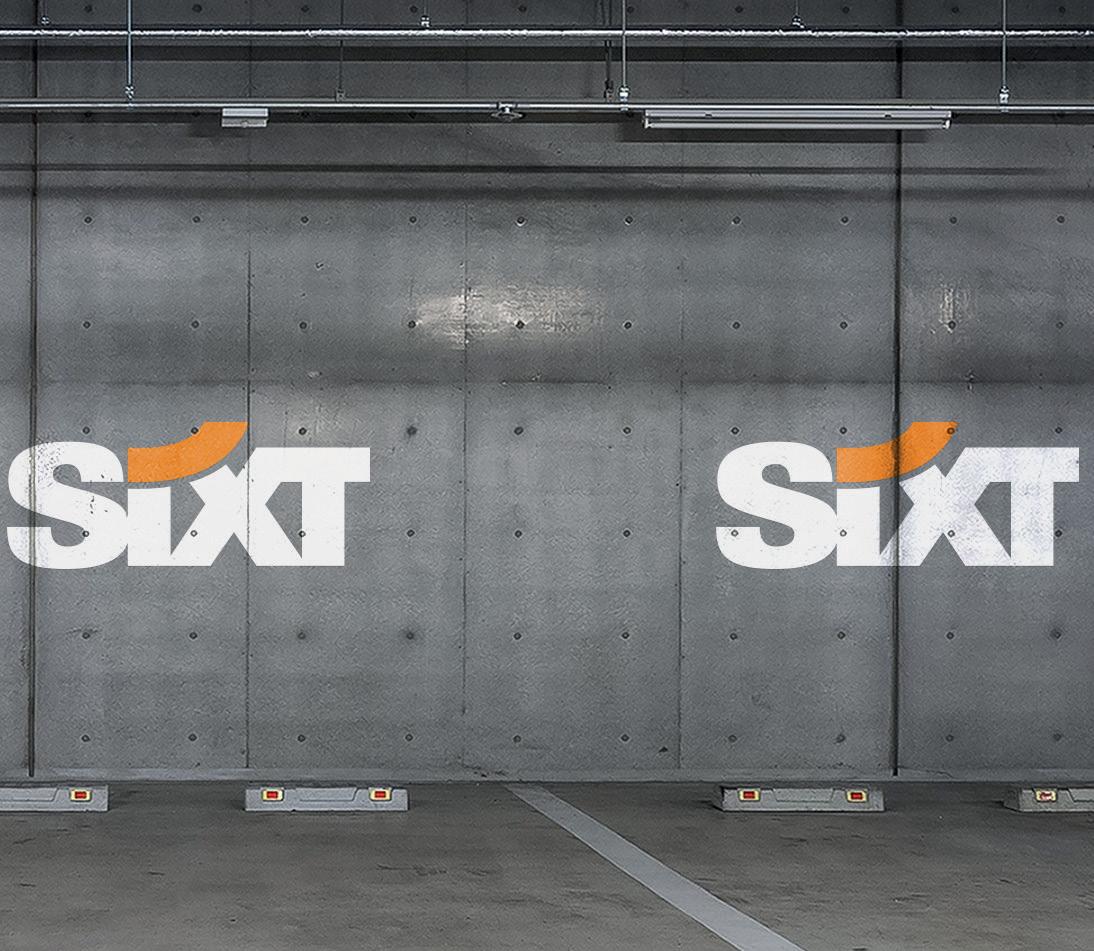

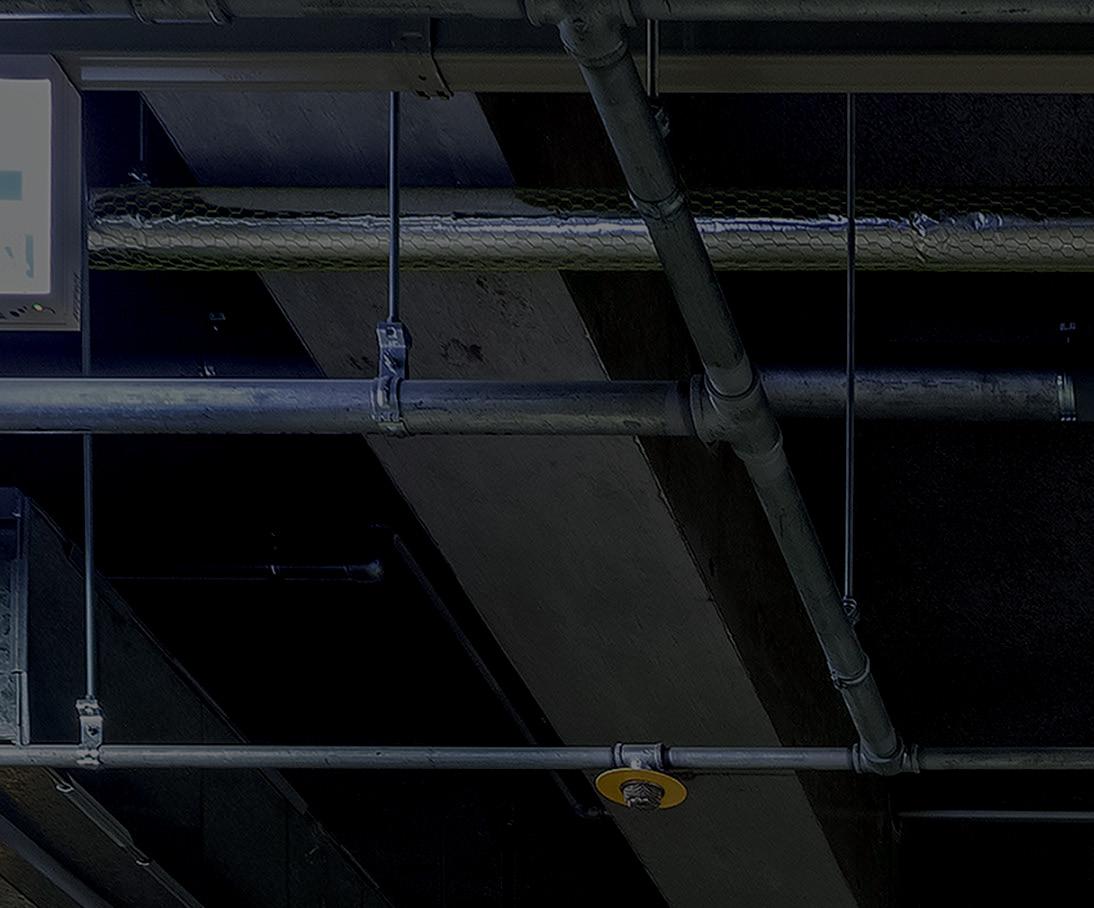
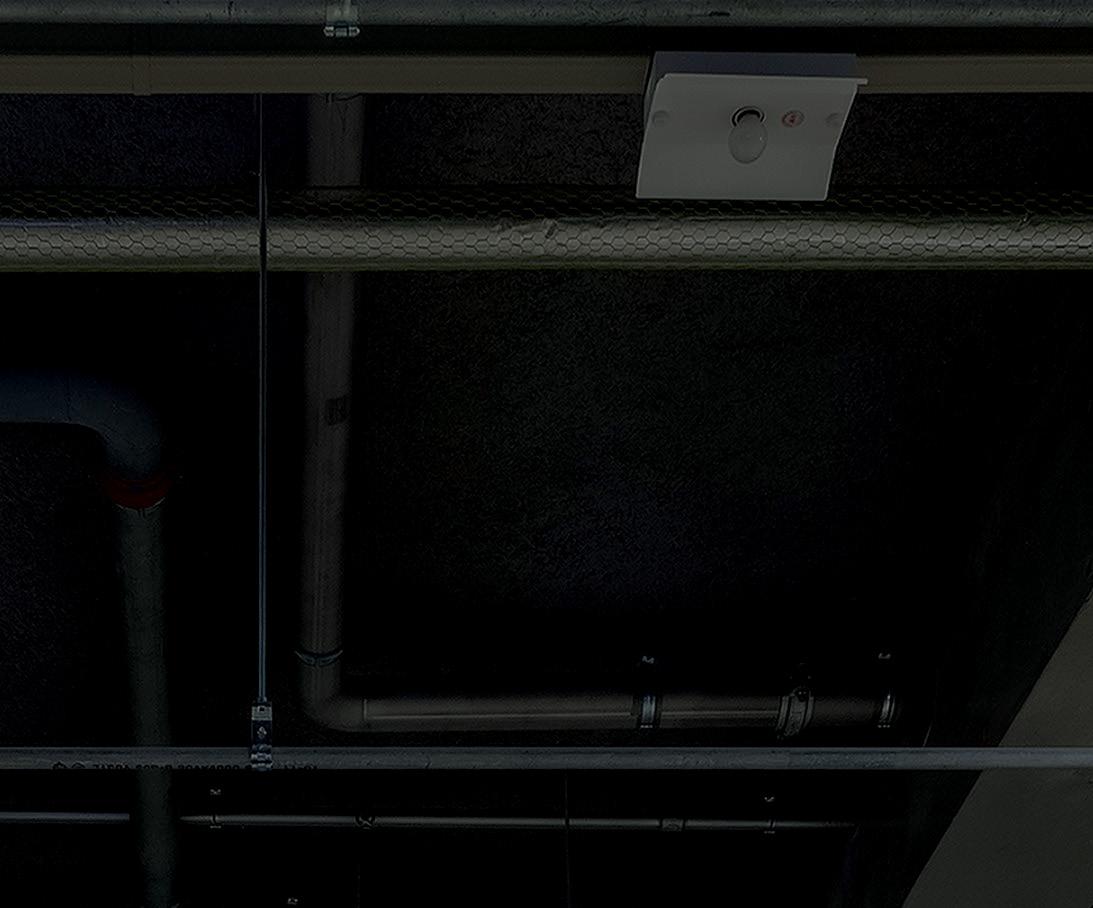






www.sixtbusiness.hu Choose your car NOW! Take it IMMEDIATELY! sixt.hu Leave parking! Business must drive on! Is there to much wait for your new company car? Let us show you the workaround: Sixt business company car offers 40 models in more than 30 categories, custom solutions, tailored for you.































































